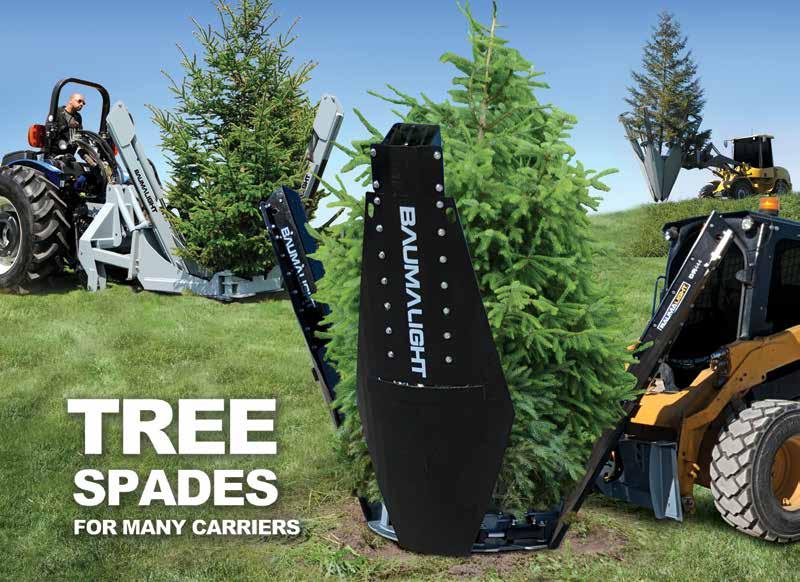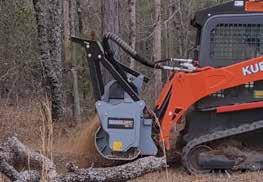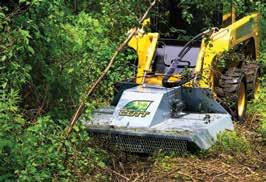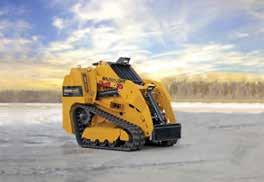


















30 Chris Teutsch Heart of America Grazing Conference…Old and Young Dogs
62 Les Anderson When You’re Hot, You’re Hot!
16 The Man Behind Eden Shale
18 Educating the Masses
20


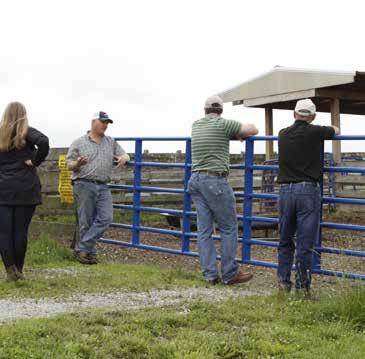
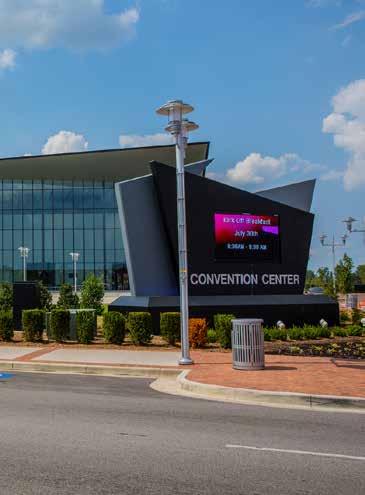


Our six-month-old is going through some sleep regression. Comfortably falling asleep for the night comes easily to some, while others may not drift off so easily. Personally, the second my feet are level with my head, I can fall asleep in 90 seconds. Couch, bed, boat, or beach chair, it doesn’t matter. I am pretty good at falling asleep and staying asleep. On the other hand, my wife needs a hot shower, soft cotton pajamas, and a bed that was neatly made after she got out of it that morning. Only then can she hit a deep sleep, no matter how short-lived it may be. My dogs simply need to burrow under a throw blanket, and they are dead to the world until daylight. Don’t even get me started on the production that is getting our son down for the night. We can go through his routine perfectly, and there is still a good chance we will see him before daylight. Honestly, there is still a pretty good chance we see him again before we go to bed. If you can’t tell, sleep is at a premium in our house right now.
In agriculture, many ways exist to get something done efficiently. It doesn’t really matter how you get there as long as you get there. When building a fence, I guarantee I lay out my line and construct it differently than many people reading this. It is just a result of the habits I have developed from the miles of fence I have built over the years. The order in which I vaccinate my calves is surely not standardized with everyone across the industry, but it allows me to keep track of when I have given all the shots without missing one. The list can go on and on about how everyone does repetitive tasks differently. Much like a bedtime routine, as long as they are not wildly inefficient, it is tough to criticize anyone’s approach to these jobs.
There are many different ways to go to sleep or keep track of redundant and monotonous tasks. There are also many ways to get a cow bred. You have artificial or natural service. Within AI breeding, you have countless different protocols. With natural service, you can either breed single-sire or multi-sire groups. You have IVF and conventional embryo transfer. As long as you use consistency in your breeding objective, I don’t care how you get a bull to fertilize an egg. Where I do start to find critique is when people are not happy with conception rates and try to increase them by diving head-first into a cocktail of additional inputs.
Increased conception rates should always be the goal, and everyone has ways to improve them. You can breed in the fall to avoid the heat. That definitely requires more harvested or stockpiled feed. You can utilize an increasing plane of nutrition going into breeding. I like that one a lot. You can use injectable mineral solutions. You can use mineral additives. You can top dress MGA crumbles to try and jump-start cycles on later calving cows. There is innumerable research on how we can work to increase conception rates. They all work to varying degrees, but they also cost something. I have always heard that the more steps in the process between a blade of grass and a cow’s mouth, the less profit there is. The same can be said for getting them bred. If you are not happy with your conception rates in your cow herd and you have to use everything I outlined above to
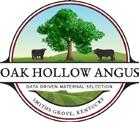
get your cows bred at a tolerable rate, you probably aren’t very profitable. Too much money is going to additional inputs to get those last few cows bred. In fact, anything past an excellent year-round mineral program and a slight bump in calories going into breeding, you will continually be throwing money at inputs.
One thing I didn’t mention in the sentences above was utilizing an environmentally adapted, maternally focused bull to sire your replacement heifers. I can guarantee you that it is not a quick fix, but I can tell you that it is the only way to make progress and wean yourself off every miracle cure for your fertility issues. That injectable solution you saw at a county meeting may seem like it will fix all your problems. However, it costs you $500 a year on a breeding group of cows to try and bump your fertility and performance. Reallocating that budget to a couple thousand more dollars on your next maternal bull to sire replacement heifers is probably the better option. In fact, it is the only long-term option.
Reproductive technologies and nutritional additives are great, and I have used all the ones I listed at one point or another on a case-bycase basis when I thought they would help my bottom line. However, if you are disappointed with your conception rates when you pregnancy check this fall, throwing all of them and the kitchen sink at your cow herd to get them to breed at a desirable rate will not be a long-term solution. You need to look at your bull selection for the last few generations and realize you may not be producing females that fit your environment because of your choices three, five, and ten years ago. While everyone in my house has their own way of falling asleep, and it doesn’t matter how they get there as long as they get there, getting your cows bred should not have the same mindset. In fact, if you just keep throwing inputs at your fertility problems, you are probably going to be the one losing sleep when you finally run out of options.
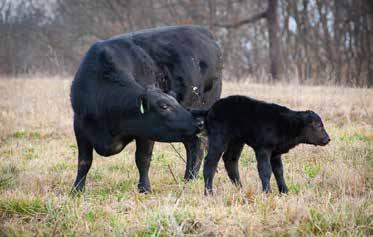
OFFICERS:
President
JEFF PETTIT Sebree
President Elect
RANDY WARNER Sharpsburg
Vice President
ALLAN BRYANT Eminence
Treasurer
KEN ADAMS Upton
Past President
ANDY BISHOP Cox’s Creek
KCA Program Chairman
DANIEL HAYDEN Whitesville
KBC Chairman
RYAN MILLER Lebanon
KBN Chairman*
ALLAN BRYANT
Beef Solutions Chairman*
DANIEL HAYDEN *ex officio
REGION 1
Wayne Zoglmann, John Mark Brown, Ashley Holloway, Leland Steely, Gary Woodall, Coleman Ladd, Susan Zoglmann, Bill Plemmons, Kenton Howard, Sara Roberson
REGION 2
Phyllis Gentry, Joe Lowe, Allison Nissley, Rayetta Boone, Robbie Hatfield, Chris Imbruglio, Maggie Webb, Mike Jones, Corbin Cowles, Glenn Byrd, Isaac Thompson, Kenneth Green, Trent Jones, Brian Manion, Joe Mike Moore, Amy Cecil
REGION 3
Amanda Hall, Nathan Lawson, James Brown, Phillip Douglas, Larry Bryant, Lincoln Clifford, Abbey Biddle, Ben Tinsley, Kevin Perkins, Kyle Bush, Michelle Simon, Craig Retzlaff
REGION 4
Amy White, Brad Reynolds, Chad Anglin, Phillip Stamm, Danielle Harmon, Bruce Witt, Jodi Purvis, Mike Ravencraft, Ronnie Lowe, Danny Callahan, Jason Crowe, Rob Amburgey
REGION 5
Adam Chunglo, Brent Woodrum, Tommy Spalding, Dean Craft, Doris Hamilton, Rick Brewer, Brent Williams, Anne Bays, Terry Mattingly, Ryan Miller, Phillip Reese, Tommy Glasscock Executive Committee

Kelly
Todd
Bradon
Rachel
Amelia
Danny
Jake Harrod KBN Program Coordinator
Dan Miller KBN Industry Coordinator
Debby Nichols National Advertising Sales, LAN
Katie Pratt Communications Manager
Alex Scott KBC Director of Nutrition
Becky
Kelly
Nikki

Jeff Pettit KCA President
Can you believe fall is near? I can’t either, but it is September whether we are ready for it or not!
I stated in last month’s article that I was getting ready to head to San Diego for the NCBA Summer Conference. It was a great summer meeting. As usual, the weather in San Diego was superb and getting to visit with other cattle producers from across the USA was very enlightening. Unless we get off the farm and visit other producers, we may never know about the struggles others are facing or the great things happening within our industry. I had not gotten any further than the Nashville airport and ran into producers that lived less than three hours from me and heard about how dry they had been. I suppose I had been so overwhelmed with the moist spring and early summer at my place I failed to realize others weren’t so fortunate! I know some of those have recently received some rain. I hope and
pray that it was enough to help them get things headed in a positive direction. While in San Diego, we heard many good presentations on topics affecting our industry. Much like the weather, we must realize that cattle producers from all over the U.S. face different problems depending on their location. That is why it is so important for us all to work together and support one another. Our strength as an industry comes from the number of producers we have working together for the greater good of all regardless of where we live. This same concept applies in Kentucky. We have a very diverse cattle industry from east to west even within our own state.
Getting back to summer conference, we heard updates on the progress of the farm bill, animal disease traceability, the avian H5N1 virus, BQA, beef council projects and much more. Who would have thought about being able to predict an animal’s health based on facial
recognition technology? If you have never attended a NCBA conference, I urge you to do so if you ever have the opportunity.
As your KCA president, I am always looking at ways to encourage and grow membership within KCA. I challenge each of you to make it a goal of trying to find someone who is not currently a member and encourage them to join KCA as our strength as an association rests in the number of producers that we represent. Keep in mind that someone can be a member of KCA, and they don’t have to be an actual producer. They just need to love beef and want to support our industry and its ability to flourish in its goal of providing quality protein to help feed the world.
If you ever have any questions or ideas you would like KCA to consider, please



Jonathan Shell Agriculture Commissioner of Kentucky
The Kentucky General Assembly has recognized September as National Poultry Month, a time to celebrate Kentucky’s place as one of the nation’s top 10 producers of the mostconsumed meat in America – chicken.
Kentucky ranked 10th in the country last year for producing more than 277 million chickens raised for meat, called broilers. Broilers were the state’s second-largest agricultural commodity in 2023 with cash receipts of $1.43 billion, trailing only corn.
When you add the more than 1.4 billion chicken eggs that the commonwealth produced in 2023, valued at $255.7 million, broilers and eggs bring in more than $1.7 billion in cash receipts.
Kentucky boasted 850 largescale poultry farms and 3,200 poultry houses in 44 counties in the commonwealth in 2022, with Kentucky’s broiler-breeder industry employing about 6,300 people.
Kentucky's poultry industry is the largest local buyer of Kentuckygrown corn and soybeans. The state’s chickens usually consume about a quarter of Kentucky-grown corn. In other words, 1 in 4 rows of corn planted in the commonwealth goes to feed the state’s hungry chickens.
I received several compliments about my dairy quiz back in June, so I put together a poultry quiz to test your knowledge and maybe learn a few interesting facts in the process.
Chickens are the most populous bird on earth. How many are there?
a. Nearly 1 billion
b. Just over 25 billion
c. More than 50 billion
d. Over 100 billion
Chickens are the descendants of what prehistoric animal?
a. bats
b. lizards
c. dinosaurs
d. none of the above
Chickens have their own language, using up to how many different sounds?
a. 12
b. 24
c. 36
d. 48
Chickens bathe themselves with what substance?
a. water
b. urine
c. mud
d. dirt
Chickens can do what?
a. Add and subtract
b. Recognize different shapes
c. See better than humans
d. All of the above
Chickens can be taught to do what tricks?
a. Swing upside down by their feet
b. Play the piano
c. Dance to music
d. Turn a somersault
Chicken feet are considered a delicacy in which country?
a. China
b. Mexico
c. India
d. Bangladesh
How many eggs does the average American eat each year?
a. 79
b. 179
c. 279
d. 379
The color of a hen’s eggs can be predicted by what part of her body?
a. feathers
b. eyes
c. feet
d. earlobes
How do most Kentuckians prefer their eggs cooked?
a. boiled
b. fried
c. scrambled
d. deviled
B, C, B, D, D, B, A, C, D, C
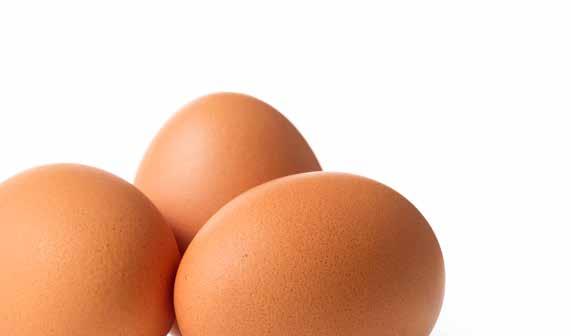








Dave Maples Executive Vice President
From Mayfield to Hazard, I have been following and participating in Kentucky Agriculture Commissioner Jonathan Shell’s listening sessions. While I have been out and about, I have also taken the time to visit some farms and talk to some of my trusted advisors in both Eastern and Western Kentucky. It is always good to be able to get out and see what our people are doing on their farms and in their businesses.
The first of Commissioner Shell’s sessions that I attended was at Murray State University. It was focused on agriculture as economic development. Most of the people that attended were county and regional economic development personnel, state government and KDA folks, and farmers.
Secretary Jeff Noel with the Kentucky Cabinet for Economic Development was the keynote speaker. This was the first time I had really ever heard the leadership from the cabinet speak. He did a nice job. Secretary Noel understands Kentucky agriculture because he grew up in it. I was also glad to see that Commissioner Shell and Secretary Noel have a nice working relationship. That relationship will be necessary if the commissioner succeeds in his goal of bringing additional food processing to Kentucky.
After the meeting, I got in the car with Dr. Shea Porr, associate dean of Murray State University’s Hutson School of Agriculture, and we followed Dean Dr. Brian Parr across campus to visit the MSU farms. All I could think about as I was riding and listening to Dr. Porr was that this would be a place that an 18-year-old farm boy from rural Alabama would fit in. I loved it.
Later that afternoon, I headed to Riley Livestock in Mayfield. Jeff, Joey, Maryann and Randy have been a good sounding board for me for a long time. When I have to deal with the really hard cattle marketing issues, I have a group of people I call and Joey and Jeff are one of the first calls. I got to go to dinner that night with Joey, Maryann, Susan Wright and Joey’s grandson Blaine. If you have ever been to the Riley’s, you know they manage thousands of cattle, and I was really interested in how they were handling the beef on dairy calves. But Blaine was insistence that I see his cow. The only pasture we went in was his pasture. The cow had a day-old calf. Blaine, nice cow, but you know you are going to have to use a better bull next time.
The following day I stopped by MSU’s Breathitt Veterinary Center in Hopkinsville to visit my friend Dr. Debbie Reed, center director. She and I both attended Western Kentucky University back in the day. Debbie was my smart friend in college, and she still is. It was good to get a chance to catch up and talk about the good old days and also the future with her.
A couple of Mondays later, I was back on Commissioner Shell’s trail. This time, we were in Hazard for a Food Is Medicine Meeting at the Hazard ARH Regional Medical Center. This time, the room was full of medical, dietary and food industry professionals. Commissioner Shell is on the right path talking to the medical community about food as health and incorporating produce and protein into the prevention and healing diet.
I could not go to Hazard without checking on my friend Larry Clay at D&D Ranch. He has been another one of my trusted advisors for 25 years. Larry lives on top of a now reclaimed strip mine. Back in the day, I would literally get run over by coal trucks going to his house, but now it’s just Larry and his cows and horses. D&D Ranch is an absolutely beautiful place, and nature is taking it back. It is neat to see the changes in the topography over time. If you want to hear some good stories and see some beautiful country, go see Larry Clay.
My last comments are about this month’s issue of Cow Country, which is focused on Eden Shale Farm. I am so proud of what we have been able to do with that farm. We have had lots of support from a lot of people from the University of Kentucky, USDA and the Owen County community, but I really want to give a big thank you to Becky, Dan, Greg and all of our staff that have made Eden Shale successful.
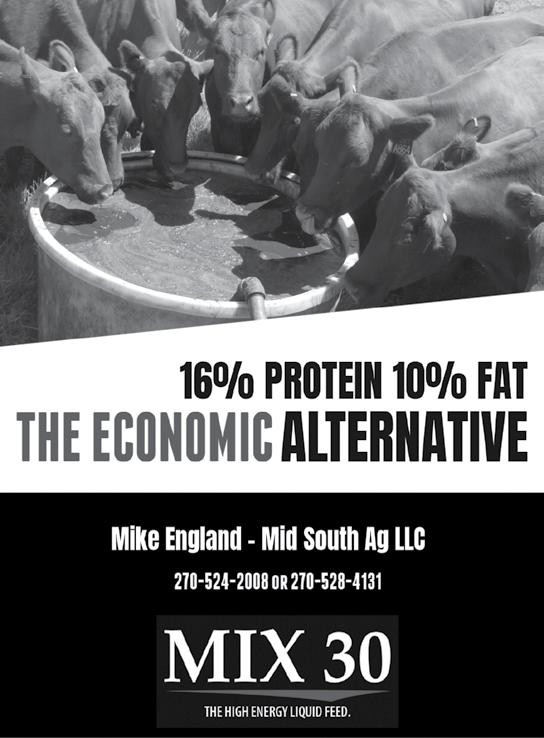



submitted by Susan Zoglmann
The Daviess County Cattlemen’s Association cooked for the county fair July 17-20. This cooking event and many others provide funds for four, $750 annual scholarships the association awards, with one scholarship awarded to a student at each of the local high schools.

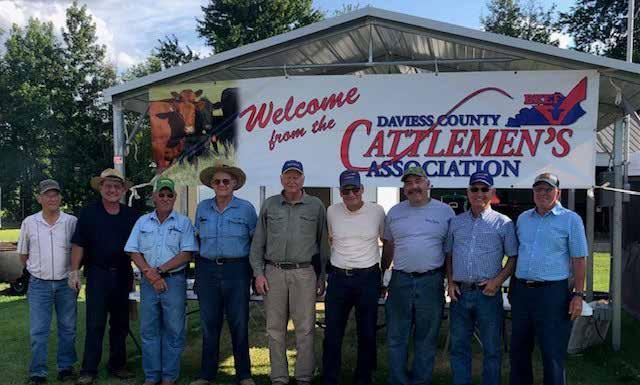
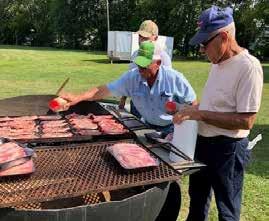

submitted by John Walpole
The Logan County Cattlemen’s Association recently awarded scholarships to deserving students in the county. Recipients this year include from left: Jenna Coles, who received the scholarship given to a college student, and high school students Abbi Walpole and Colby Collins. All recipients are majoring in or plan to major in an agriculturerelated field. They are surrounded by Logan County Cattlemen’s Association board members from left: Connor William, Wayne Johnson, Jerrod Hollaway, Lonny Epley and John Walpole.
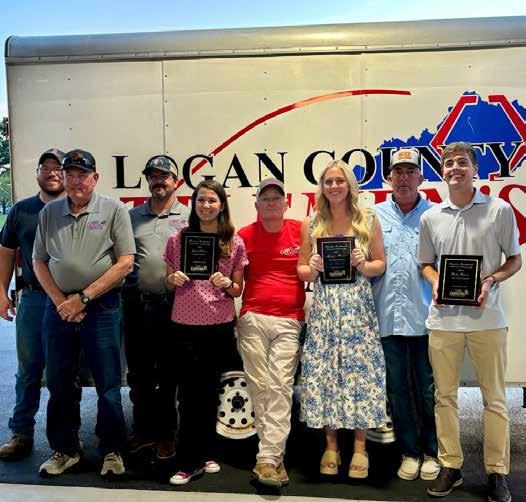
submitted by Rita
Spalding
The Marion County Cattlemen’s Association recently awarded five, $1,000 scholarships to local 2024 seniors to further their education in agriculturerelated or veterinary studies. Pictured are: Steve Downs, county president, scholarship recipients Jackson Willett, Dylan Gibson, Isabella Daugherty and Noah VanDyke and Rita Spalding, secretary. 2024 senior Trey Murphy also received a scholarship but was not present for the photo.
submitted by Bradley Willcox
President Charley House of the Hardin County Cattlemen’s Association awards Danica Street a heifer donated by John Edwards. Congratulations to Danica as she is the 2024 winner of the Heifer Contest sponsored by the Hardin County Cattlemen’s Association. Danica is a happy, young cattle producer.
submitted by Annette Walters
Cade Doyle and Lindsey Dotson were each awarded a $500 scholarship by Mason County Cattlemen officers Annette Walters, treasurer and Ronnie Lowe, president at the Livestock Improvement Association Sale in July.
Cade has been involved with cattle since he was given a bred heifer to “start his herd” at the age of 5. His knowledge of the cattle industry has been enhanced by his experience working on the family farm under the guidance of his grandfather. Cade has developed a strong work ethic, perseverance and love for cattle farming. He has shown leadership skills by mentoring younger showmen. Cade has earned many awards, but his proudest achievement was winning Grand Champion at the


Kentucky State Fair with a bull that he raised. He now leases the bull to others and uses it as a clean-up bull for the family herd.
“Agriculture has always been a part of my life and always will be,” Doyle said.
Lindsey has developed a love for and knowledge of Simmental beef cattle. Her involvement in the cattle industry has shaped her into a strong, fierce and independent person. Her communication skills, dependable nature and ability to work with customers of all ages has made her a valuable person in the local entertainment industry.
“The cattle industry to me is so much more than just about cattle. It’s about lifelong friendships, leadership skills, determination and so much more,” Dotson said.

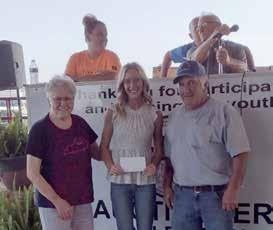
WASHINGTON (July 23, 2024) –Today, the National Cattlemen’s Beef Association (NCBA) confirmed that efforts to prevent ultra-processed, lab-grown protein from showing up in the diet of the American armed forces were successful, following news that the U.S. Department of Defense (DoD) is not pursuing labgrown protein projects for human consumption.
“NCBA was the first and only cattle group to uncover this stream of DoD funding that could go toward labgrown protein projects, and we were the first and only group to fight back,” said NCBA President and Wyoming rancher Mark Eisele. “After weeks of engaging with Congress and speaking out against this plan, we are thrilled to have DoD confirmation that labgrown protein is not on the menu for our nation’s service members. These men and women make the greatest sacrifices every day in service to our country and they deserve high-quality, nutritious and wholesome food like real beef grown by American farmers and ranchers.”
NCBA has worked with agriculture allies in Congress to secure the introduction of several amendments to the Fiscal Year 2025 Defense Appropriations bill, National Defense Authorization Act, and Fiscal Year 2025 Agriculture Appropriations bill, aimed at preventing lab-grown protein from ever showing up on the plates of American service members. Cattle producers appreciate the leadership of Rep. Don Bacon (RNE), Rep. Zach Nunn (R-IA), Rep. Warren Davidson (R-OH), Rep. Mary Miller (R-IL), Sen. Roger Marshall (R-KS), Sen. Cynthia Lummis (RWY) and Sen. Deb Fischer (R-NE) in standing up for farmers, ranchers and our military. NCBA also issued a statement drawing attention to these DoD grants and NCBA members also discussed their concerns with this plan in national media.
“The Department of Defense can and should be on the cutting edge of
science, and we respect their work to investigate defense applications for new tools and technology. However, there’s a big difference between industrial or defense applications and the food we put in our bodies. U.S. farmers and ranchers are more than capable of meeting the military’s need for high quality protein,” said NCBA Senior Director of Government Affairs Sigrid Johannes. “NCBA appreciates the DoD’s responsiveness on this issue, and we thank our allies in Congress, including Senator Fischer, Congressman Davidson and Congressman Bacon, for quickly acting to ensure that only the most wholesome and unprocessed products end up on the plate for our service members.”
Farms and Ranches Structured as Certain Legal Entities Are Required to File Beneficial Ownership Information Reports Under New Law WASHINGTON (Aug. 5, 2024) – The National Cattlemen’s Beef Association (NCBA) is reminding cattle producers to consult with their tax attorneys regarding the Corporate Transparency Act, with key deadlines approaching at the end of 2024. NCBA’s grassroots members recently passed policy at the 2024 Summer Business Meeting directing the association to take action on the Corporate Transparency Act, including outreach and education to cattle producers.
The Corporate Transparency Act was passed by Congress in 2021 and requires companies to report beneficial ownership information to the Financial Crimes Enforcement Network (FinCEN), a division of the U.S. Department of the Treasury. The goal of the legislation is to reduce financial crime, but the new mandate will impact farmers and ranchers whose operations have fewer than 20 employees and are structured as corporations such as limited liability
companies (LLC) or companies that are registered with the secretary of state.
“Farmers and ranchers need to speak with their tax attorneys to make sure they are not in violation of this new law, and to submit necessary information to FinCEN before the Dec. 31 deadline,” said NCBA Tax and Credit Committee Vice Chair Jeff Magee, a Mississippi cattle producer and former Internal Revenue Service agent. “I strongly encourage you to review the resources on www.fincen. gov/boi to determine if the Corporate Transparency Act applies to your business. Deadlines are coming up soon and failing to comply with the law can carry a fine of $500 per day and possible jail time. For more information, contact FinCEN and consult your attorney or tax professional.”
Farms and ranches that are structured as corporations, LLCs or other entities that file with the secretary of state may be subject to the Corporate Transparency Act and required to file a “beneficial ownership” report with FinCEN, identifying the individuals who own or manage the operation. For companies registered and operating before Jan. 1, 2024, the deadline to file this report is the end of 2024. Companies registered or created in 2024 have 90 days from the date of registration or creation to file their beneficial ownership report. In 2025, the reporting period will be reduced to 30 days.
These reports require basic identifying information like legal name, date of birth, and home or business address. Resources, including a frequently asked questions document and a Small Entity Compliance Guide, and the filing form are available online at www.fincen.gov/boi. Producers with additional questions should contact FinCEN by calling 1-800-767-2825 toll free or 703-905-3591.
Every producers’ situation is different, and this information should not be construed as professional advice. Always consult your attorney and/or tax professional to determine how the Corporate Transparency Act impacts you.

PROTECT YOUR BOTTOM LINE AGAINST REDUCED APPETITE AND WEIGHT LOSS.

Stress happens every time cattle are handled, transported or commingled.
Cortisol levels increase from stress impacting appetite, health and weight gain. Studies demonstrate FerAppease® reduces the impact of stress on calves treated:*
• Reduced cortisol levels
• Improved appetite
• Increased weight gain

• Improved immunocompetence
• Improved health response, better recovery
• Decreased mortality
*Conducted by Dr. Reinaldo F. Cooke, Texas A&M University
HEALTHIER & HEAVIER CALVES = MORE PROFIT

CONTACT YOUR VETERINARIAN OR ANIMAL HEALTH PROVIDER TODAY.

On any given day if someone stands on a ridgetop at Eden Shale Farm, they are likely to see Greg Cole on horseback checking on or moving cattle along the sloping terrain or repairing fences, checking mineral supplies, working animals and many other tasks that keep the Owen County farm running smoothly.
Cole is the Eden Shale Farm’s manager and ambassador. He is responsible for the 951-acre farm’s daily operations and managing the Kentucky Beef Network’s herd that averages around 100 cow-calf pairs. He is also responsible for sharing Eden Shale’s story with producers, tour attendees or anyone who happens to stop by.
“He’s an exceptional cattleman,” said Dan Miller, Kentucky Beef Network industry coordinator. “He’s as good at working with cattle as anybody that I know.”
The son of a Fayette County order buyer, Cole has been around the cattle industry his entire life. He decided early on he enjoyed working with animals on the farm way more than being at the stockyards. Prior to his current position, Cole worked for KBN and performed onsite audits for the process verified program that arose after bovine spongiform encephalopathy (BSE) was detected in a cow in Washington state.
When KBN took over management of Eden Shale and purchased their initial herd in May 2013 from area stockyards, Cole began bringing his sons and horses to the farm to help work and rotate the cattle as volunteers. When the ambassador position came open, Cole expressed interest.
Cole moved his family to the farm in August 2013 and brought his horses with them. Over the years, his horses have proven to be a valuable asset to Eden Shale. Cole uses them to navigate the farm’s steep terrain and, in some cases, he and his horses can
Katie Pratt Kentucky Cattlemen's Association

get into areas of the farm that other methods of transportation cannot.
Unlike the other KBN facilitators who travel to their producers’ farms to assist in production needs, farmers come to Eden Shale to learn about the farm and gain information about ways they can improve their operation from Cole. Often, these producers come because they have heard about the farm and its best management practices that improve animal production and welfare while saving producers time and money.
The farm hosts numerous group tours but also walk-in visitors.
“Greg will do a lot of walk-up and one-on-one tours anytime they are needed,” Miller said. “Most of his clients will only come to the farm once or twice to get the information they need to take back to their operation.”
Often, these walk-up tours occur without any prior notice. Since Cole resides full-time at the farm, he conducts one-on-one tours during


evenings, weekends and even holidays if someone visits.
When KBN purchased their initial set of cows from local stockyards in 2013, quality was lacking in the herd. The first year, they had a 47% cull rate. Over the years, Cole and Miller have worked to develop the herd into one that can withstand the area’s steep terrain and also serve as good mothers. As a result, the average weight of a cow on the farm has dropped from 1,500 pounds to 1,275 pounds. He and Miller have used genetics and artificial insemination to increase calf weaning weights by 100 pounds. They have also used artificial insemination and cleanup bulls to tightened their calving window. They have achieved over 90% of calves being born in the first 45 days since 2021. This spring, they had their tightest calving window yet when 96% of the calf crop was born in the first 49 days of the calving season. Half of them arrived in the first 22 days.
Cole keeps meticulous records on the cattle at Eden Shale. He uses his Redbook to record everything about the cattle including the amount of grain, hay and minerals each animal receives as well as the animal’s medical history and reproductive health. As a result, he often has a big part in deciding which animals to cull.
“I start looking at quality but I also
look at productivity and disposition when making culling decisions,” Cole said. “Over the years, our quality has improved and now our cattle’s disposition is really good.”
Since Cole is located at the farm and responsible for the animals’ daily care, he has a unique insight into each of the animals.
“He can spot a sick animal two days before I can,” Miller said. “He also does really well during calving season and keeping animals alive.”
Eden Shale’s cattle also participate in research trials with scientists with the U.S. Department of Agriculture’s Forage-Animal Production Research Unit. Cole works with the researchers to manage the animals in projects to their specifications, such as ensuring the cattle get the nutrition and water as prescribed by the experiment and stay in the correct research group.
“Greg has been instrumental in conducting our collaborative research projects with KBN at Eden Shale Farm,” said Brittay Davis, USDA animal scientist who studies ways to mitigate the negative effects of endophyte infected tall fescue at the farm. “He always does a great job selecting the correct cattle from the farm herd for each experiment, overseeing their daily care and assisting with sample/data collection
days. Most importantly, Greg helps provide a cattleman's perspective to each project weighing in on everything from experimental design, grazing strategies and animal management.”
Being responsible for the farm’s daily upkeep, Cole approaches the farm with a practical mindset. As a result, he has been able to point out areas of the farm that need improvements, such as when they were feeding hay out of the bull barn when KBN first started managing the farm. Miller and Cole worked with Steve Higgins from the University of Kentucky to improve their winter-feeding situation.
“Feeding hay in the barn was tight and slow,” Miller said. “By creating a fence line feeder in the barn, we were able to make the task simple enough for one person to do. We measured how long it took Greg to feed the old way and with the fence line feeder, and it reduced his time spent feeding the animals by 500%.”
While he has helped make much progress at Eden Shale, Cole is always looking for areas of the farm and aspects of the herd to improve.
“There’s a saying that says, ‘If you enjoy what you do, you will never work a day in your life,’” he said. “I really enjoy the work I do up here. It’s what I was born to do.”
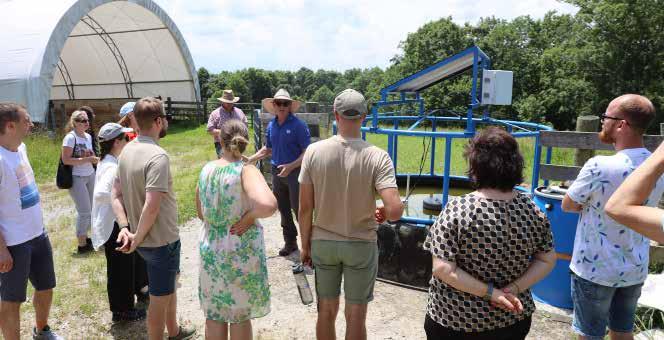
Katie Pratt Kentucky Cattlemen's Association
OWENTON, Ky., − Since the Kentucky Beef Network took over management of the Owen County farm in 2013, staff from KBN and the University of Kentucky have educated cattle producers from all over the world about ways to improve the efficiency and sustainability of their operations.
KBN operates Eden Shale Farm like most Kentucky cowcalf operations. It includes a spring-calving herd of around 100 mama cows. The farm relies solely on the money it receives from the sale of its cattle for its annual budget. To keep in line with its budget, KBN and UK staff have implemented numerous management practices at Eden Shale Farm to improve efficiency, reduce costs, reduce time spent in the field, improve cattle comfort and keep the farm profitable. During a typical farm tour, attendees will see some of these efficiencies including the popular fence line feeders, tire waterers, winter feeding options and various water systems.
Eden Shale’s ability to raise a quality herd with limited resources has garnered attention from across the world. In the 10 years that KBN has managed the farm, more than 4,200 people have visited. These include producers and industry representatives from 114 Kentucky counties, 35 states and 20 countries.
“Ten years ago, I would have never dreamt that we would be able to educate producers, get practices adopted into
cost share, influence regulations, and host international visitors all at Eden Shale Farm,” said Dan Miller, KBN industry coordinator. “Both the reach and influence of the farm has become a valuable asset to the Kentucky Cattlemen’s Association.”
Tours at Eden Shale vary from walk-in tours given to local producers or people just driving through the area to organized national and international events. Earlier this year, Eden Shale hosted a group from the European countries of Estonia, Lithuania and Latvia. This tour was organized with the help of the U.S. Department of State. Participants were up-and-coming young professionals in their respective fields and recommended by their country’s embassy. Eden Shale was one of the stops on their tour across the U.S.
Aleksejs Nipers, a senior researcher and associate professor at Latvia University for Life Sciences and Technologies, was part of this group. He studies ways Latvian producers can manage the land to get the highest return on investment not only for themselves but for society as a whole. He also engages policymakers in his country to make policies that are most beneficial for rural development. He enjoyed comparing agriculture in the two countries.
“We have local challenges related to climate policy, nutrient cycling and biodiversity, but these are also challenges that occur in other parts of the world,” he said. “Programs like this allow us to work with other countries like the U.S. to understand what is happening in the bigger picture and together develop solutions to these challenges.”
Eden Shale is known for its hands-on education practices and often serves as a living laboratory for tour participants. On a recent tour this summer, high school science teachers from across the U.S. learned about ways they can

incorporate agriculture into their classrooms. This tour was part of the On The Farm STEM Program, a fourmonth immersive learning experience through American Farm Bureau Foundation for Agriculture, a contractor to the Beef Checkoff.
“We hope the teachers use what they learn from the program to help their students become more knowledgeable consumers, see that science that occurs on a beef farm, and develop a deeper understanding of agriculture processes,” said Rick Henningfeld, program facilitator.
Angela Ugbajah teaches biology and environmental sciences in Clayton County Public Schools in Jonesboro, Georgia, a suburb of Atlanta. She participated in the program to better help her students develop an appreciation of where their food comes from. Most of the students she teaches are not familiar with agriculture.
“My most important takeaway from this tour is how cattle are affected by their environment and how producers and researchers use engineering and environmental science concepts to improve the cattle’s environment,” she said.
In addition to scheduled tours throughout the year, KBN opens Eden Shale Farm to producers each October during its annual field day. This year’s field day is Oct. 19. To schedule a tour of Eden Shale Farm, contact the Kentucky Cattlemen’s Association at 859-278-0899 or email kbn@ kycattle.org.

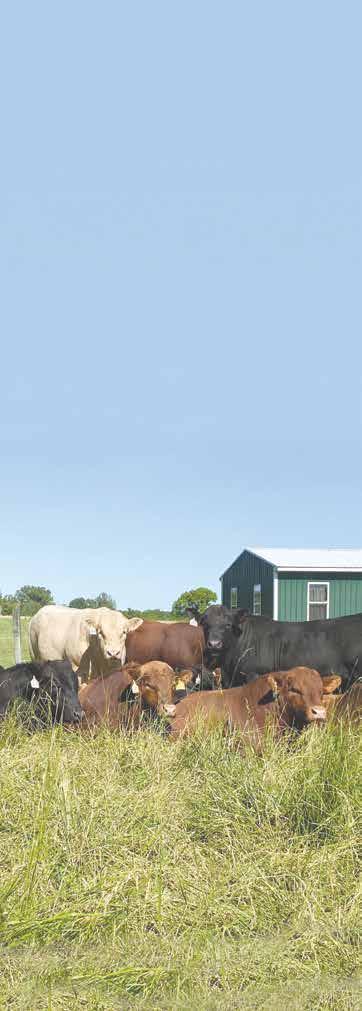




At Red Hill Farms, our maternal selection goals include cows that have longevity, breed regularly, calve easily and early in the breeding season, and wean a high percent of their body weight. In addition, we put extra emphasis on udders, feet and disposition. Profitability starts with the cow!
SimGenetics bulls at Red Hill are selected to add payweight in all phases of production –weaning, yearling and carcass. As a bonus, these bulls are selected for KY-31 fescue adaptability, slick hair, good feet and remarkably calm dispositions. These bulls are ideal for mating to British-based cows to produce calves with added hybrid vigor, feedlot demand and consumer acceptance. 231A, along with other Red Hill sires, have proven track records of adding value in all segments of the beef business!









Katie Pratt Kentucky Cattlemen's Association
In the past decade, Eden Shale Farm has garnered global attention from producers seeking to enhance their operational efficiency, reduce fieldwork time and create a better environment for their cattle. This interest is due to innovative water, feed, and mud reduction systems designed by Steve Higgins, the director of animal and environmental compliance at the University of Kentucky Martin-Gatton College of Agriculture, Food and Environment.
“Technically, the ideas aren’t new, and someone built something similar because I found many of the ideas in really, old books,” Higgins said. “Some of the ideas and design concepts are literally thousands of years old, while the most popular ideas with producers are about 80 years old. I guess my inspiration comes from a wise person who once said, ‘If you want a new idea, read an old book.’”
Since the Kentucky Beef Network took over Eden Shale Farm in 2013, Higgins has collaborated with KBN staff to install these best management systems across the farm. His grantfunded projects have transformed the farm into a living laboratory for practical improvements, many of which have been integrated into the state's cost-share program.
“Dr. Steve Higgins is an invaluable industry partner. His work has
created outside interest for Eden Shale and made us relevant to cowcalf operators,” said Dan Miller, KBN industry coordinator. “His work has helped us gain efficiency in our operation and run a 951-acre farm with 1.5 men.”
Key improvements and innovations include:
One of Higgins' earliest and most impactful projects was converting the farm's dairy barn into a maternity barn for heifers. He removed the old dirt floor and installed geotextile fabric, dense grade aggregate, geogrid, more dense grade aggregate and a top layer of wood shavings. This flooring reduces mud, filters waste and provides a comfortable, non-slip surface for calving heifers. Additionally, he reconfigured the barn pens with gates to suit various calving needs.
“Our heifers spend 24-48 hours in the barn when they give birth,” Miller said. “His designs help ensure their labor and delivery go normally. We also have a chute in the barn in case we need it to pull a calf or milk a cow.”
Higgins also installed a Bo Renfrostyle feeder outside the former dairy barn on a concrete pad and a fence line feeder at the barn's back

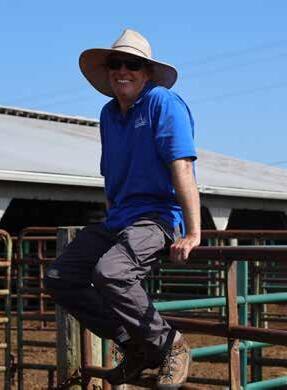
for winter feeding. Strategic gate placement allows heifers and other cattle easy access to the hay. A nearby stack pad stores manure removed from feeding areas, which is later used to enhance soil fertility across the farm.
Effective water resource management is crucial to Eden Shale Farm’s success. Higgins designed various rainwater capture systems across the farm, including one at the maternity barn. At the maternity barn, he installed new gutters and PVC pipes to collect rainwater from the roof, depositing it into one of four, 3,000-gallon tanks. These tanks gravity feed a tire waterer, strategically placed and fenced so multiple animals from different pastures can drink at the same time.
In 2015, a salmonella outbreak linked to wet soil conditions led to the loss of 14 calves and four cows within two weeks. This incident prompted the farm to implement more of Higgins’
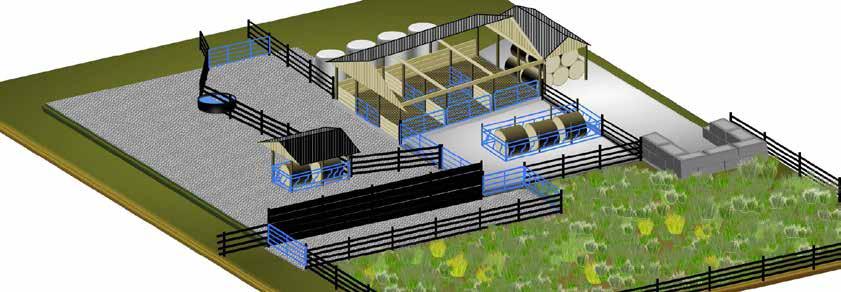
The location had a pre-existing building placed on a summit position in close proximity to farm manager’s house. The soils had approximately 4 inches of topsoil and a restricted root layer when the survey was conducted in 1976. Organic content in the soils is low making the soild roughty. Runoff is rapid and permeability is low.
The facility is a hub in which three neighboring pastures are used to simultaneously manage cows at
A. Lanes & Alleys
Surfaces - Use all-weather surfaces to control the creation of mud and provide solid footing for animals (grid). Gates & Hardened Lanes - Utilized to move cattle into designated areas for calving, monitoring, feeding, and watering.
B. Centralized Waterer
A tire waterer was installed to distribute harvested water. The calculated water volume is approximately 700 gallons. The idea behind its use is to provide numerous animals with access to clean water at the same time. An ample water volume provides a water source as the supply is replenished. Dividing tire in half allows groups from two different pastures access. Placing the waterer in a hub allows many groups to utilize the source. Tire should be cleaned weekly, or as needed.
different stages of pregnancy while also providing a centralized winter-drought feeding area. The system is designed with all-weather surfaces to control the creation of mud and provide animals with a solid footing.Gates and lanes are used to move cattle into designated areas for calving, monitoring, and feeding and watering. Bedding on the calving floor provides a clean, dry surface that is needed for young animals.
C. Water Harvesting
Precipitation is collected while at the same time diverting stormwater. Harvested water is then used to meet animal requirements. The roof collection area is ~4,000 square feet. A one-inch rainfall event provides 3,400 gallons of water. Four tanks are used to hold 12,000 gallons.
D. Primary Winter-Drought Feeding Area
Concrete surface was pre-existing. A centralized feeding area provides the ability to feed multiple groups of animals. Roll bales are stored in an adjacent barn to reduce travel time, fuel, and pollution. The close proximity of the house and hay means the operator spends less time feeding.
E. Manure Storage
Manure is a resource. It has a value as a fertility and as an organic matter
mud management designs. One solution involved installing gravelfilled tires along the hillside to create a less muddy path for cattle to the maternity barn.
Each practice that he added contributed to the creation of an efficient centralized hub. The combined practices improved producer efficiency and increased livestock production, while protecting the environment. Higgins developed
There are numerous systems implemented around the facility to increase productivity and profit, while simultaneously decreasing the adverse effects of farming on the environment. Although this looks expensive and complicated, the “Cow Campus” was created by simply adding individual practices to improve existing operations.The end result is a complex that improves production while reducing the drudgery of farming.
material. It is applied on the farm to reduce inputs. A stack pad was created to handle the manure from the feeding structures.
F. Filter Strip-Vegetative Terrace
It acts as a filter strip to remove nutrients, pathogens, and sediment from runoff originating from the feeding area. The ability of the vegetated filter strip to remove contaminants has been enhanced by ripping the sod along the contour. This act creates a terracing effect that slows runoff and allows it to better infiltrate the soil profile. The result is deeper root growth and increased vegetative production. This area is then allowed to be creep grazed by calves or flash grazed by mature cows.
1. Pasture 1 holds the heavy bred cows. As pregnant cows come out of pasture 1 to the shared waterer and
other locations into activity hubs.
His demonstrations include forage feeding systems like fenceline feeders and automated self-feeders. He has also focused on improving livestock drinking water and controlling the creation of mud.
“Since we have become better managers of our mud, we have lost zero animals related to sickness, zero animals due to being stomped on at the feeder, and have had no animals
main feeding area, they are checked for calving status. If calving is observed as imminent, they are moved into the calving barn.
2. The Calving/Feeding Barn is used to provide shelter for cattle. It is used to provide confinement, protection, and handling and care.
3: This small pasture acts as a nursery and allows easy monitoring of pairs. Once calves are observed feeding and records are made, the pair is turned into this pasture. It provides suitable surfaces and a windbreak for protection. Cows are provided hay housed under a roofed structure, and have access to the shared tire waterer.
4: After monitoring pairs for a few days, pairs are turned out into a larger pasture, which represents typical pastures for the farm.
with broken legs,” Miller said.
Eden Shale Farm's ongoing improvements and innovative systems serve as a model for efficiency, environmental stewardship and animal welfare in livestock farming.
Plans and more information on Eden Shale’s best management practices are available at www.edenshalefarm. com/producer-resources.html.
Brittany Davis, Ph.D. USDA Research Animal Scientist
Tracy Hamilton Agriculture Research Technician
If you have had the opportunity to go to Eden Shale Farm for a tour or field day (if you haven’t, you should!), you may have visited the paddocks (Figure 1). The 23 paddocks, approximately two-acres each at Eden Shale are located on steep hillsides, making them nearly impossible to manage or renovate. These paddocks also consist of predominantly HOT endophyte-infected (E+) tall fescue grass, which makes them the perfect representation of the typical Kentucky cattle pasture. For this reason, these paddocks have been used for the last 30+ years, first by University of Kentucky researchers and for the last 15 years by Kentucky Beef Network (KBN) in collaboration with our research team at the USDAARS, Forage-Animal Production Research Unit (FAPRU) to evaluate and demonstrate cattle management strategies for preventing fescue toxicosis.
Let’s start with a little fescue toxicosis refresher. When cattle consume lush E+ tall fescue pastures, toxins produced by the endophyte that lives in the plant can cause vasoconstriction or reduced blood flow. This can lead to several health and production problems including increased susceptibility to heat stress, reduced growth and decreased reproductive performance. All-in-all, fescue toxicosis has been estimated to cost the beef industry more than $2 billion every year. For that reason, researchers like our team focus on finding solutions for producers to prevent fescue toxicosis. It has long been recognized that cattle grazing E+ tall fescue pastures perform better if there is clover in the pasture. This has usually been attributed to improvements in pasture quality and ‘dilution’ of the toxins because cattle have
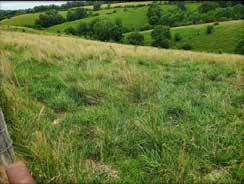
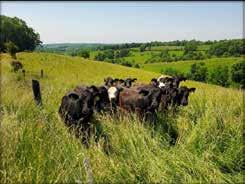
another high-quality forage to select. Although, this may be true, our research team at FAPRU have identified phytochemicals present in legumes (most notably red clover) that can increase blood flow, or have a ‘dilation’ effect, preventing fescue toxicosis and leading to improved animal health and growth (+25% higher average daily gain). Our research over the years has shown that these benefits can be achieved in grazing steers with several different management strategies including: frost-seeded red clover, supplemented legumes from a variety of sources, or with very low levels of red clover leaf (less than 1 oz. per day) mixed in conventional loose mineral.
One concern for application of this magic red clover fairy dust
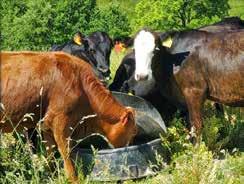
is that these phytochemicals are also phytoestrogens and could impact fertility if consumed by breeding stock. So we wanted to know, what about heifers? Will these phytochemicals, even at low concentrations, impact fertility?
To investigate this, KBN and Eden Shale Farm teamed up with FAPRU, Burkmann Nutrition, and reproductive expert Les Anderson at UK to find out how red clover leaf mineral impacts heifer behavior and fertility. In 2021, 2022 and 2023, the replacement heifers at Eden Shale Farm were divided into two treatment groups that were either provided a free choice control conventional loose mineral or the same mineral with added red clover leaf (Figure 2). Heifers were managed by Greg Cole, Eden Shale Farm’s manager, with rotational grazing on the E+ tall

fescue paddocks. Each year, heifers underwent two rounds of fixed-time artificial insemination (May and June) and fescue toxicosis and heat stress-related measurements were collected serially over the grazing season. Heifers were also outfitted with COWMANAGER® Ear Sensors, kind of like a Fitbit for cows, to continuously track their behavior.
In result, the Eden Shale heifers consuming the red clover treatment mineral had greater blood flow, higher daily activity and reduced respiration rates, indicating that the mineral helped to prevent fescue toxicosis vasoconstriction and related heat stress. Interestingly, we did not see any difference in conception rates between treatments in May when environmental conditions were thermoneutral (60 – 65% conception rates), but when the temperature and humidity started to rise in June, heifers consuming the red clover mineral had 40% higher conception rates than the heifers consuming control mineral. Overall, red clover mineral resulted in a pregnancy rate benefit of more than 20%. Based on our results from this three-year grazing study, there were no apparent negative impacts of red clover at the rate provided in the free choice mineral. In fact, there appears to be great reproductive and heat stress benefits that could have significant economic implications for our cowcalf producers here in Kentucky and across the fescue belt.
To wrap this up, I would like to say how grateful we are for our continued collaboration with KBN at Eden Shale Farm. This farm, Greg Cole and Dan Miller, KBN industry coordinator, have provided us a unique opportunity over the years to test and demonstrate several different management strategies that could help provide Kentucky cattle producers tools to increase the overall performance and health of their herds. We look forward to learning more from our ongoing collaborative project in the paddocks at Eden Shale Farm evaluating this red clover mineral in grazing steers. Stay tuned for more on that!



Michelle Arnold DVM (Ruminant Extension Veterinarian, UKVDL)
“Acute Respiratory Distress Syndrome” or “ARDS” is a rapid and dramatic onset of severe breathing difficulty due to lack of oxygen transfer across the air sacs (alveoli) in the lungs to the bloodstream. Affected cattle exhibit open-mouth breathing with the head and neck extended, nostrils dilated, a swayback appearance, foam coming from the mouth, an open-shouldered stance, and may sometimes show aggression (see Figure 1). Breathing is shallow and rapid (35-75 breaths per minute) and may have a loud grunt associated with exhalation. The cattle’s temperature is typically normal but may be mildly elevated due to the severity of the condition. In extreme cases, air pockets can be felt under the skin on the upper portions of the neck, shoulders and back (subcutaneous crepitation). Mild exercise may cause the animal to collapse and die. Generally, there is no coughing nor signs of infection, such as fever or depression. Severely affected animals frequently die within 2-3 days after initial onset of clinical signs.
There are a variety of “agents” that will directly or indirectly damage the linings of the alveoli and blood vessels
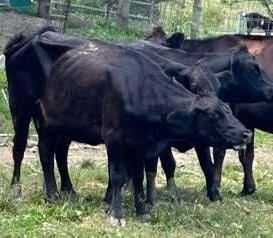
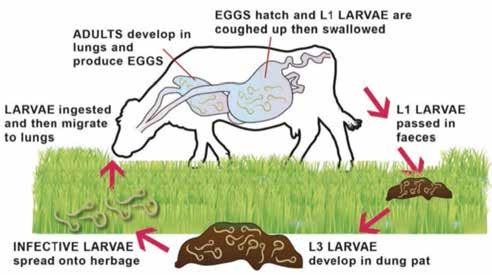
in the lungs of cattle, preventing gas exchange and initiating respiratory distress. The most common offenders are 3-methyl indole (3-MI), a toxin produced when cattle are moved from dry to lush pastures with increased L-tryptophan or when grazing Brassicas, the ketones in the weed perilla mint, certain respiratory viruses, lungworm infections, and sepsis from bacterial infection.
Although most producers are familiar with pneumonia in cattle, lungworms are usually left off the list of possible causes. This is because respiratory disease due to lungworms is both uncommon and unpredictable, yet it can be devastating in a herd. Lungworm disease outbreaks are most often seen in grazing calves and yearlings exposed to the parasite for the first time when they have no immunity and are therefore completely unprotected. But occasionally, outbreaks are seen in adult cattle if their immunity has waned from lack of exposure or pasture infectivity is high.
The lungworm life cycle (Figure 2) begins when cattle consume infective L3 larvae in the pasture, typically during wet summers or when grazing in swampy areas. After
ingestion, larvae penetrate through the intestine, mature to the L4 stage in the mesenteric lymph nodes, then migrate to the lungs and break into the alveoli in a week’s time. These larvae continue to migrate to the airways and mature into adult worms inside the bronchi and trachea (Figure 3). From 26-60 days after infection (called the “patent phase”), the mature worms deposit eggs in the airways, causing a “parasitic bronchitis.” The eggs hatch and the L1 larvae ascend the trachea, mostly by causing the animal to cough and are swallowed then excreted in the feces. The L1 larvae mature to L2 then L3 in the fecal pat, spread to pasture and are ingested to begin the cycle anew. The severity and duration of clinical signs depend on the number of and how quickly the larvae are consumed. ARDS develops from a hypersensitivity to the larvae migrating through the lungs that causes an overreaction by the immune system and subsequent damage to lung tissues. Proteases and enzymes are also released by the larvae that directly damage lung tissue as they travel.
Within an affected group of cattle, symptoms of lungworm infection may range from a mild, intermittent
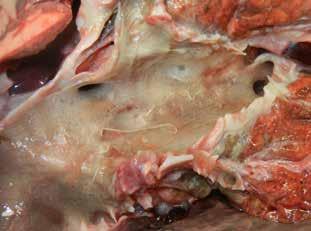
cough and weight loss up to severe difficulty breathing and death. Most animals gradually recover although it may take weeks to months. At the cellular level (visible through a microscope), this very distinct pattern of lung injury is called “diffuse alveolar damage” or “DAD” and is the most frequent microscopic finding in animals exhibiting acute respiratory distress. The old name of “Atypical Interstitial Pneumonia” or “AIP” has fallen out of favor due to confusion arising from a similar human disease with the same acronym.
Diagnosis of this type of pneumonia resulting from DAD, known as “interstitial pneumonia”, is easily performed at necropsy because it is a very different pattern from the typical shipping fever pneumonia.
“Shipping Fever” or “Bovine Respiratory Disease (BRD)” causes a “bronchopneumonia” that typically occurs at the junction of the air sacs and the airways leading to them. On postmortem examination, damaged areas of shipping fever lungs are firm, red-tan, and mostly in the cranioventral lung lobe. With interstitial pneumonia, on the other hand, damage is to the “interstitium” or supporting structures of the lungs including the lining of the air sacs, the lining of the blood vessels and the septa (divisions) between the lung lobes. These structures become filled with fluid and white blood cells, making the lungs wet, heavy and meaty with a firm, rubbery texture, and they do not collapse when the chest cavity is opened. The lungs are often over-inflated. The entire lung may be diffusely involved or affected areas are dark red to purple and may be interspersed with normal looking
Figure 4: Ingestion of perilla mint causes acute respiratory distress syndrome as described with fog fever. Animals are frequently found dead with mature cattle most often affected but it can occur in yearlings and calves. Treatment is of limited value and severe cases seldom survive. Photo by J.D. Green.
lobules, creating a “patchwork” or “checkerboard” appearance. Cattle often develop secondary bacterial pneumonia after the initial lung injury.
One of the first respiratory diseases known to cause ARDS in grazing cattle was acute bovine pulmonary edema and emphysema (ABPEE) or “fog fever,” a condition reported in Europe over 200 years ago. ABPEE typically occurs in the fall 4-10 days after cattle are moved from dry summer pastures to lusher fall pastures, but it can occur any time of the year. Lush pasture contains the amino acid tryptophan, which can be metabolized by the organisms in the rumen to 3-methyl indole (3-MI). The 3-MI is absorbed into the bloodstream, transported to the lungs and metabolized to a new compound 3-methyleneindolenine (3MEIN) that causes widespread cellular injury in the lung. Recent studies have found that tryptophan levels in pastures associated with fog fever are not exceptionally higher than unaffected pastures. Instead, it is the abrupt change from grazing the poor-quality dry forage to lush pasture that results in altered rumen microflora capable of metabolizing tryptophan to 3-MI. Nursing calves are not at risk for fog fever, and yearlings are less susceptible than adults. Brassicas including kale, rape and green turnip tops are rich sources of tryptophan that can be converted in the rumen to 3-MI and also cause ARDS to develop. Cattle that survive typically show dramatic improvement after 3 days with recovery spanning approximately 10 days. Severely affected animals that survive may develop chronic emphysema or heart
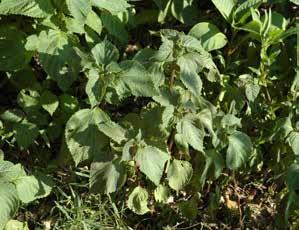
Feeding an ionophore, such as monensin or lasalocid, has been shown to reduce the conversion of tryptophan to 3-MI in the rumen by as much as 90%. For an ionophore to be effective, it must be present in the rumen at the time of exposure. Little effect remains in the rumen 48 hours after removal from the diet, so prevention involves continuous feeding of an ionophore while the cattle are at risk of tryptophaninduced lung damage.
Other potential causes of ARDS in animals from ingested toxins include 4-ipomeanol from consuming Fusarium solani-contaminated sweet potatoes, perilla ketone from grazing purple mint (Perilla frutescens-see Figure 4), ingestion of the herbicide Paraquat, and ingestion of stinkwood (Zieria arborescens). Additional noninfectious causes of ARDS include hypersensitivity (allergic) reactions such as adverse drug events or allergic pneumonitis from inhalation of mold spores, chronic left heart failure and pancreatitis.
Treatment decisions by the veterinarian will depend upon determining the etiology of the clinical signs but, if treatment is attempted, must be handled very cautiously. A dart gun may need to be employed to avoid having to move the animal to a treatment facility as these animals die quickly when exercised. Treatment recommendations typically include diuretics and anti-inflammatory medications to facilitate breathing and antibiotics to prevent secondary bacterial infections.
Rachel Cain Kentucky Cattlemen's Association
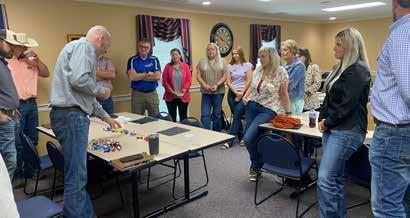

Class X of the Kentucky Cattlemen’s Association Leadership Development Program met for their first session on July 30 – Aug. 1 in Lexington. The group’s first stop was the Kentucky Cattlemen’s Association office where Dave Maples, executive vice president, welcomed the class and encouraged the class to take full advantage of the program. Dr. Kimberly Heller, Vezeto Leadership Consulting, led the class through the first day of activities. Participants learned more about each other and themselves through various exercises. The group discussed the current state of the beef industry and their visions for the future.
On Day Two, the class traveled to Hustonville to visit Branch View Angus. The group heard from James Coffey, whose family operation breeds around 200 home-raised and customer purchased heifers annually and sells over 150 bulls privately and through their annual sale. In 2008, Branch View Angus began feeding steers at Pratt Feeders. They use the harvest and feed data, along with maternal data, to guide breeding decisions. Tim Dietrich and Danny Smith led the group on a full tour of the operation.


The next stop was Burkmann Nutrition in Danville. With 15 farm store and plant locations across Kentucky and Tennessee, Burkmann Nutrition provides feed for livestock, equine and poultry, as well as farm supplies and animal health products. Dr. David Williams, who co-founded the company in 1978, shared the history of the company and how it has evolved over the years to meet the changing needs of the beef industry. Austin Sexten, technical services nutritionist, and Tom Hastings, corporate vice president, led a tour through the storefront and facilities of their flagship location.
Nikki Whitaker, KCA director of operations and policy, met with the class on Wednesday afternoon to discuss the structure and governance of the Kentucky Cattlemen’s Association as well as provide an update on the Livestock Innovation Center. Wednesday night, the class wrapped up with an Etiquette Training Dinner at Dudley’s on Short. Robin Hammond of Southern Hospitality and Etiquette highlighted the importance of etiquette, manners, and social skills, and discussed real-world application of these skills.
On Thursday morning, the group traveled to Eden Shale Farm in Owenton for their final stop. For most of the class, it was their first time visiting the farm. University of Kentucky researcher Steve Higgins and Dan Miller, Kentucky Beef Network industry coordinator, led the group on a tour of the farm, highlighting several practices at Eden Shale and facilitating discussion about how these practices could be implemented on their own operations.
Class X is funded by Kentucky Cattlemen’s Foundation. Session Two is scheduled for Fall 2024 in Louisville.
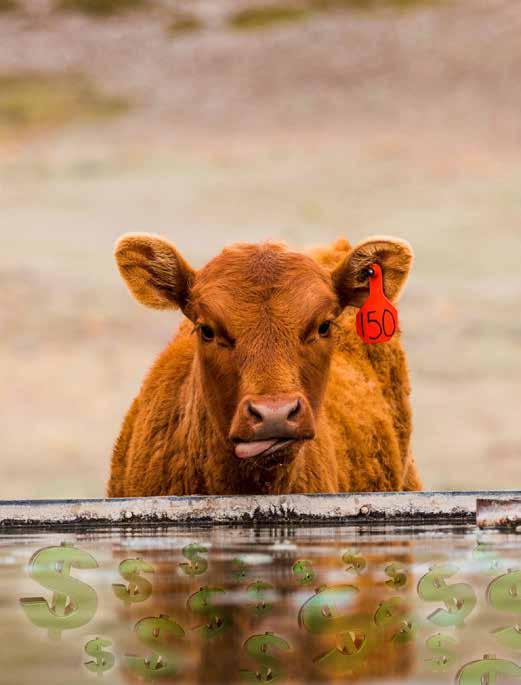

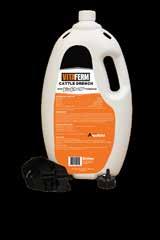
Nikki Whitaker Director of Operations and Policy
The Kentucky Livestock Innovation Center is excited to announce the launch of its website, www. livestockinnovationcenter.org. The new website will showcase the highlights and benefits of the Livestock Innovation Center and provide construction updates.
Website visitors can get a comprehensive overview of the facility, including detailed background information, center objectives and key priorities for stakeholders, industry professionals and the general public.
In addition to providing insights into the center's goals and initiatives, the website features a Frequently Asked Questions (FAQ) page that answers the most commonly asked questions and provides a timeline of the center’s accomplishments to date.
One of the standout features of the website is its News section. This area will be regularly updated with the latest information and developments related to the center. Whether it’s progress reports, event announcements or other important updates, the website aims to keep stakeholders well-informed and engaged.
About the Kentucky Livestock Innovation Center
The Kentucky Livestock Innovation Center will create an environment that engages both learning and teaching opportunities for producers, food and retail partners, and others to support and communicate continuous improvement of livestock production, economic vitality and sustainability.
This facility will serve as a central coordinating location to advance the socioeconomic benefit of agriculture to the Commonwealth of Kentucky by fostering collaboration in education, innovation, marketing and research.
Kentucky Livestock Innovation Center is managed by the Kentucky Cattlemen’s Foundation with partnerships from the Kentucky Livestock Coalition and the University of Kentucky Martin-Gatton College of Agriculture, Food and Environment. For more information, please visit www. livestockinnovationcenter.org.
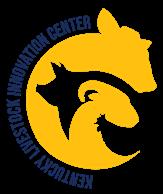

SATURDAY,
CENTRAL KENTUCKY ANGUS SALES PAVILION DANVILLE, KY
BULLS: All are DNA tested and will sell with current BSEs
FEMALES: Open heifers, Bred Heifers, Spring & Fall pairs, Bred cows
Entries are incomplete at this time, so watch the October issue of Cow Country, or better yet, request your copy of the catalog now and be ahead of of the rush!
DATE SATURDAY, OCTOBER 5, 2024
TIME 1:00 pm EDT
PLACE CENTRAL KY ANGUS SALES PAVILION 4 MILES NE OF DANVILLE JUST OFF OF HWY 34 ON CHENAULT BRIDGE RD AND THEN FORK CHURCH ROAD. GPS address: 2286 Fork Church Road, Lancaster, KY 40444
SALE DAY PHONE 859.238.3195 or 859.583.0364
SALE MANAGER DIEVERT SALES SERVICE TIM DIEVERT 478 DRY FORK ROAD DANVILLE, KY 40422 859.238.3195 • tdievert@dievertsales.com Like us on facebook. For more details contact the sale manager.
CENTRAL KENTUCKY ANGUS ASSOCIATION OFFICERS
President Tom McGinnis
Vice-President Alex Popplewell
Secretary Kris Lynn
Treasurer John Goggin
Town Creek Farm bulls hold up, out-work, out-last and out-perform their peers. Fewer bulls to replace. Thirty years of developing proven bulls. They work!
√ Select your bulls from proven Brangus (selection of 1st gen 3/8-5/8 bulls) Ultrablacks, Vigor Max™ (Brahman x Angus half-blood), 3/4 Blood and Brahman Bulls.
√ Opportunity to buy bulls from a program that culls EVERY open female and EVERY female that doesn’t bring a calf to weaning pens.
√ Cattle fit the commercial world, backed by good cows behind our bull offering.
√ Maternal bulls develop superior replacement heifers that are fertile, long-lasting and have good udders.
√ Offering full two-year-old bulls.

√ Large selection of calving ease heifer bulls.
√ User-Friendly bulls.
√ Bulls are hard, ripped and toned; ready for breeding pastures.
√ Managed to be disease-free. ALL bulls are out of Johnes-free cows.
√ Environmentally adapted and acclimated bulls that withstand heat and humidity.
√ Longevity – of breeding bulls and of their daughters.
√ Fertility is our top priority. All other traits follow fertility.
√ Genetics developed and proven for more than 30 years.
Saturday, October 19, 2024 • 12 noon at the ranch near West Point, Mississippi
150 Brangus, VigorMax™ Half-Blood Bulls, and Ultrablack & Plus First Gen Brangus Bulls 250 Commercial Brangus Bred Heifers
Go to www.TownCreekFarm.com to request a sale catalog.
TOWN CREEK FARM
Milton Sundbeck, Owner
32476 Hwy. 50 East, West Point, Mississippi 39773-5207
Joy Reznicek Sundbeck (205)399-0221 Joy@TownCreekFarm.com Cody Glenn (601)508-8689 Cody@TownCreekFarm.com
Logan Perry, Florida, (863)634-4810 www.TownCreekFarm.com

Chris Teutsch UK Research and Education Center, Princeton
Everyone has heard the old saying, “old dogs can’t learn new tricks.” I don’t believe it! We are all lifelong learners, although that learning seems to take a little longer as we age! This fall, Kentucky will be hosting the Heart of America Grazing Conference in Elizabethtown on Oct. 15- 17. This conference is a multi-state effort and will draw more than 200 livestock producers from Kentucky, Illinois, Indiana, Missouri, Ohio and Tennessee. The theme of this year’s conference is “Regenerative Grazing…Merging Science and Practice” and will feature a pasture ecology workshop on Oct. 15 (limited to 60 participants) and a banquet that evening (open to all) featuring the photography of Jimmy Henning. The main conference will be on Oct. 16 and a regenerative pasture walk on Oct. 17. More information on the conference and how to get registered can found on the UK Forages website, https://forages.ca.uky.edu/events, or by contacting your local extension office.
The pasture ecology workshop will be held at Glenmar Farms near Cecelia. The workshop will be led by myself, my University of Kentucky colleague Ray Smith and Matt Poore from North Carolina State University. Participants will learn about temporary fencing and watering systems, annual forages, dung beetles and nutrient cycling, understanding the potential and limitations of soils (soil viewing pit), Eastern gamagrass and clover mixtures, and silvopasture establishment and management. This workshop is LIMITED to 60 participants. So, make sure and sign up early!
The evening following the Pasture Ecology Workshop will be the Heart of America opening banquet. This event is open to everyone. The banquet will feature a photographic journey into the beauty of forages

Matt Poore, extension specialist and regenerative grazier, will put all the pieces together with his closing keynote address.
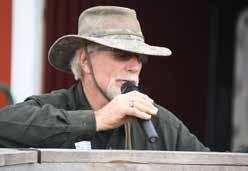
by our own Jimmy Henning. Jimmy has worked as a forage extension specialist and associate dean for more than three decades. He also publishes an annual calendar featuring barns of Kentucky and leads our annual grazing calendar effort.
The main conference will be the following day. Our opening keynote speaker, Ray Archuleta, will share his passion for soil conservation and regenerative grazing. Ray has more than 30 years of experience as a soil conservationist and educator. His presentation will address how to use regenerative grazing to improve the soil on our farms. Following Ray’s presentation, Alan Franzluebbers
Ray Archuleta’s passion for soil conservation and regenerative grazing is unmatched!

Greg Brann of Big Spring Farm in Adolphus during his 2023 pasture walk.
from the USDA-Agricultural Research Service Unit located at North Carolina State University will discuss what we know and what we don’t about soil health and regenerative grazing. Greg Halich from UK will round the morning out with a robust discussion of using bale grazing to improve soil fertility and health.
Following lunch, Sam Kennedy of Kettle Mills Livestock Company in Hampshire, Tennessee, will share his regenerative journey. I will then talk about all the different organisms that live in a healthy pasture soil and how we can manage to create a habitat that encourages their growth and nutrient cycling. Our
closing keynote speaker Matt Poore of North Carolina State University will talk about putting all the pieces together into a sustainable grazing system that improves profitability, optimizes animal health and wellbeing and enhances environmental sustainability. Matt has more than 30 years of experience as a ruminant livestock extension specialist and regenerative grazier. He currently coordinates the Amazing Grazing Program at NCSU and a two-week pasture ecology workshop held for Natural Resources Conservation Service employees from around the country.
The third and final day of the conference will feature the annual regenerative pasture walk at Greg Brann’s Big Spring Farm in Adolpus. Greg has more than four decades of experience as a NRCS grassland
Kentucky Intermediate Grazing School, forages.ca.uky.edu/Events.
specialist and regenerative grazier. He and his partner Debby produce pasture-finished meat, milk and fiber on their grazing operation. Topics covered on the pasture walk will include walnut silvopasture, native grasses, annual forages, optimizing the use of existing forages, multispecies grazing, stockpiling for winter grazing and managing weeds in pastures.

Heart of America Grazing Conference…Regenerative Grazing office • Oct. 15-Pasture Ecology Workshop at Glenmar Farms, Cecilia • Oct. 16-Main Conference, Elizabethtown • Oct. 17-Regenerative Pasture Walk at Big Spring Farm, Adolphus • Come one day, two days or all three days! More information at https://forages.ca.uky.edu/events.
FEATURED VIDEO
The Power of Soil Life: The Little Things Matter by Ray Archuleta, https://www.youtube.com/ watch?v=WW6-RmmcA0o. This presentation was given as part of the 2022 Fall Grazing conferences titled, "Profitable Grazing Systems from the Soil Up," which was held Oct. 26-27 in Leitchfield and Winchester, respectively. This and many more presentations are available on the KYForages YouTube Channel
FEATURED PUBLICATION
This month’s featured publication is: “Nutrient Cycling in Pastures” by Dave Scott and Nina Prater, ATTRA. You can access it by clicking https://tinyurl.com/subfc6mk or visiting your local extension office.
Use high quality temporary fencing. Temporary fencing comes in a number of styles including polywire, electric tape, electric braid and polyrope. Electric tape should be used where high visibility is needed. Polywire is most commonly used by graziers since longer runs can be held on reels. When selecting polywire products, choose products that contain more strands of wire and for longer runs, choose products that contain wire made of mixed metals. Polywire containing mixed metals are about 40 times more conductive.
FORAGE MANAGEMENT TIPS
• Soil sample, and apply any needed lime and fertilizer.
• Plant annual and perennial cool-season grasses and legumes. Consider incorporating novel endophyte tall fescue into your grazing system.
• Harvest late summer hay as needed. Do not harvest alfalfa after mid-September.
• Do NOT overgraze perennial pastures in late summer and fall. Pasture plants accumulate energy reserves in the fall that are used to overwinter and regrow in the spring.
• Feed hay and allow cool-season pastures to stockpile for winter grazing.
• Rest native warm-season pastures until after frost to enhance winter survival and subsequent productivity.
• If drought occurs, confine animals to one pasture and feed hay.
LARGER SEED HOPPERS • CLEAN VIEW SIGHT GAUGE • CLEAR VIEW SEED MONITOR WINDOW • 12 FT DRILL • NEW TECHNOLOGY HIGH SPEED DRILL 8MPH! • SWING TONGUE FOR 8”10” TRANSPORT • WILL PLANT BIN RUN SEED! • FINANCE OPTIONS AVAILABLE!

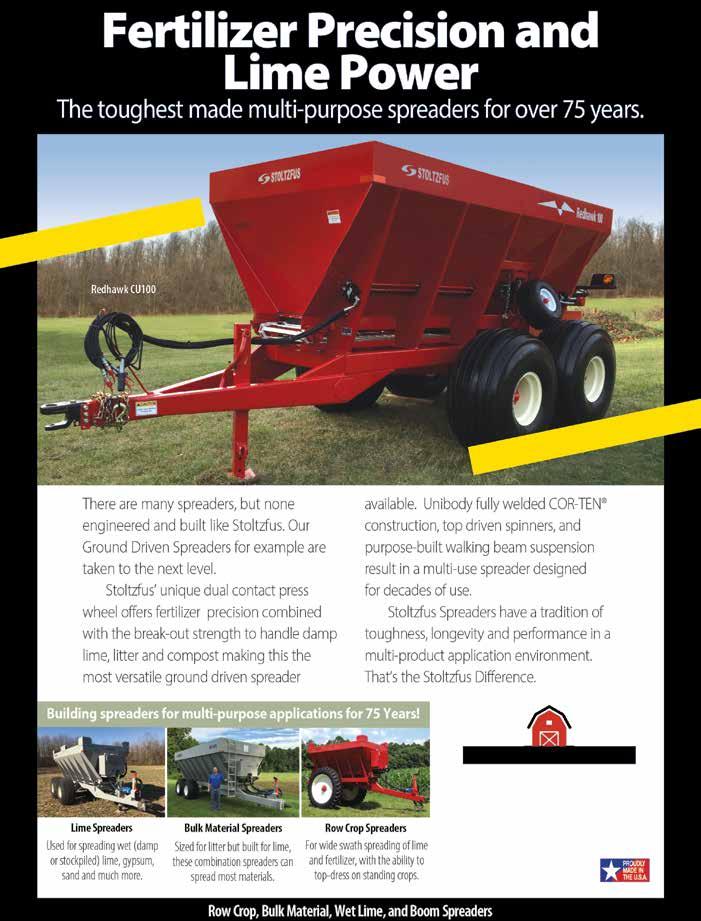


Landon Miller KJCA director at-large
The Kentucky Junior Cattlemen’s Association is coming off a big year with new state events, such as the Cattle Working Contest, KJCA Academy and the Auburn Veterinary Mentorship Program. We also reached our highest membership numbers yet, topping out at 1,002 members! We have several great opportunities for our members coming up. Our board that plans these events are dedicated individuals that care about the future of the KJCA.
The KJCA will host the Fall Classic, our biggest member event this year Oct. 4-6 at the Western Kentucky University L. D. Brown Expo Center in Bowling Green. Participants can compete in a variety of contests including ad design, sales talk, photography, skillathon, team fitting, judging and showmanship. We will, of course, have our cowcalf, bull, breeding heifer and prospect market shows as well. Back by popular demand, the KJCA Academy will be Oct. 22 at the Hardin County Extension office. The Kentucky Junior Cattlemen's Academy is an awesome event where members get to learn a lot about cattle in a hands-on format. This year, they’ll cover things like Beef Quality and Care Assurance training, how to work with and handle cattle, and how to manage vaccines and needles. Additional chute-side demos will help teams who are interested in competing in the Cattle Working Contest in the spring. To get more information or to register for the academy, visit https://www.kycattle.org/juniorcattlemens-academy.html.
experience industry tours including feedlots, farms/ranches and other beef-related entities. This event is funded by the Kentucky Beef Council and is open to any Kentucky high school sophomores, juniors and seniors. Students are selected through an application process, which you can find at www.kycattle. org/nybls. The application deadline is Oct. 1. If you have any questions, email Bradon Burks, KBC director of education, at bburks@kycattle.org. We also started the KJCA Points Program, which encourages and rewards members for being active and involved in county and state activities and for promoting beef and cattle in Kentucky. Members track their points all year and submit their totals by Oct. 6. The top member from each age group will be honored at the annual KCA Convention, and the top three counties will also get recognized. Portfolios can be turned in on the KCA website.
(5 mg/mL doramectin, 150 mg/mL levamisole hydrochloride)
CAUTION: Federal law restricts this drug to use by or on the order of a licensed veterinarian.
INDICATIONS:
TM
(5 mg/mL doramectin, 150 mg/mL levamisole hydrochloride)
CAUTION: Federal law restricts this drug to use by or on the order of a licensed veterinarian.
INDICATIONS:
VALCOR™ is indicated for the treatment and control of the following species of parasites in beef cattle two months of age and older and in replacement dairy heifers less than 20 months of age. Not for use in beef bulls intended for breeding over 1 year of age, dairy calves, and veal calves.
Gastrointestinal Roundworms (adults and fourth stage larvae): Ostertagia ostertagi (including inhibited larvae), O. lyrata, Haemonchus placei, Trichostrongylus axei, T. colubriformis, T. longispicularis*, Cooperia oncophora, C. pectinata*, C. punctata, C. surnabada, Bunostomum phlebotomum*, Strongyloides papillosus*, Oesophagostomum radiatum, Trichuris spp.*, Nematodirus helvetianus*. Lungworms (adults and fourth stage larvae): Dictyocaulus viviparus. Eyeworms (adults): Thelazia spp. Grubs (parasitic stages): Hypoderma bovis, H. lineatum. Sucking Lice: Haematopinus eurysternus, Linognathus vituli, Solenopotes capillatus. Mange Mites: Psoroptes bovis, Sarcoptes scabiei. *Adults only
Eligible KJCA members can apply for the Nebraska Youth Beef Leadership Symposium, (NYBLS). On this trip, students will get to
WARNINGS AND PRECAUTIONS: WITHDRAWAL PERIODS AND RESIDUE WARNINGS:
Another one of our biggest competitive programs is the Youth Beef Heifer Initiative. There will be three winners, each from a different age group. Division l consists of ages 9-13; Division ll is ages 14-17, and Division lll is 18-21. Farm Credit Mid-America provides a big helping hand in this event and aims to increase the youth’s engagement and strengthen their interest within the industry. Each winner will receive $2,000 to purchase a heifer from a Kentucky Cattlemen's Association member. Anyone interested can visit the KCA website for more details. We have a lot going on and hope you plan to join us for all of these wonderful activities. It’s a pleasure to serve this organization and all of our members. I hope to see you soon!
Cattle must not be slaughtered for human consumption within 15 days following last treatment with this drug product. Not for use in female dairy cattle 20 months of age or older, including dry dairy cows; use in these cattle may cause drug residues in milk and/or in calves born to these cows or heifers. Not for use in beef calves less than 2 months of age, dairy calves, and veal calves. A withdrawal period has not been established for this product in pre-ruminating calves. User Safety Warnings: Not for human use. Keep out of reach of children. If accidental eye contact occurs, flush eyes immediately with water for 15 minutes and seek medical attention. If wearing contact lenses, flush eyes immediately with water before removing lenses then continue rinsing
product. Wash hands after use. Take care to avoid accidental selfinjection. If accidental injection occurs, seek medical attention and provide product package insert to medical professional. To obtain a Safety Data Sheet(s), contact Zoetis Inc. at 1-888-963-8471 or www.zoetis.com.
Animal Safety Warnings and Precautions:
Use of levamisole in cattle treated in the last few days with cholinesterase inhibitors such as organophosphates or with morantel may enhance the toxic effects of levamisole. Use together with caution. Destruction of Hypoderma larvae (cattle grubs) at the period when these grubs are in vital areas may cause undesirable host-parasite reactions including the possibility of fatalities. Killing H. lineatum when it is in the tissue surrounding the gullet may cause bloat; killing H. bovis when it is in the vertebral canal may cause staggering or paralysis. These reactions are not specific to treatment with VALCOR™ and can occur with any successful treatment of grubs. Cattle should be treated either before or after these stages of grub development. Consult your veterinarian concerning the proper time for treatment. Follow recommended dosage carefully.
Reproductive safety has not been evaluated in bulls intended for breeding.
ADVERSE REACTIONS: This product is likely to cause swelling at the injection site. Tissue damage at the injection site may also occur, including possible granulomas and necrosis. These reactions have resolved without treatment. Local tissue reaction may result in trim loss of edible tissue at slaughter. A single death attributed to clostridial infection associated with the injection of VALCOR™ was reported in a nonpivotal effectiveness study. Observe cattle for injection site reactions. If injection site reactions are suspected, consult your veterinarian. This product is not for intravenous or intramuscular use. Hypersalivation may be observed; however, this reaction will disappear within a few hours. If this condition persists, a veterinarian should be consulted.
Contact Information: Contact Zoetis Inc. at 1-888-963-8471 or www.zoetis.com. To report suspected adverse drug experiences, contact Zoetis Inc. at 1-888-963-8471. For additional information about reporting adverse drug experiences for animal drugs, contact FDA at 1-888-FDA-VETS or http://www.fda.gov/reportanimalae.
TARGET ANIMAL SAFETY:
Margin of Safety: Subcutaneous administration of VALCOR™ was well tolerated in calves as young as 3 months of age at 1, 2, or 3 times the recommended dose. Dose-dependent post-dose hypersalivation was seen in all treated groups compared to the controls. All cases of
VALCOR™ is indicated for the treatment and control of the following species of parasites in beef cattle two months of age and older and in replacement dairy heifers less than 20 months of age. Not for use in beef bulls intended for breeding over 1 year of age, dairy calves, and veal calves.
bulls intended for breeding over 1 year of age, dairy calves, and veal calves.
Gastrointestinal Roundworms (adults and fourth stage larvae): Ostertagia ostertagi (including inhibited larvae), O. lyrata, Haemonchus placei, Trichostrongylus axei, T. colubriformis, T. longispicularis*, Cooperia oncophora, C. pectinata*, C. punctata, C. surnabada, Bunostomum phlebotomum*, Strongyloides papillosus*, Oesophagostomum radiatum, Trichuris spp.*, Nematodirus helvetianus*. Lungworms (adults and fourth stage larvae): Dictyocaulus viviparus. Eyeworms (adults): Thelazia spp. Grubs (parasitic stages): Hypoderma bovis, H. lineatum. Sucking Lice: Haematopinus eurysternus, Linognathus vituli, Solenopotes capillatus. Mange Mites Psoroptes
Gastrointestinal Roundworms (adults and fourth stage larvae): Ostertagia ostertagi (including inhibited larvae), O. lyrata, Haemonchus placei, Trichostrongylus axei, T. colubriformis, T. longispicularis*, Cooperia oncophora, C. pectinata*, C. punctata, C. surnabada, Bunostomum phlebotomum*, Strongyloides papillosus*, Oesophagostomum radiatum, Trichuris spp.*, Nematodirus helvetianus*. Lungworms (adults and fourth stage larvae): Dictyocaulus viviparus. Eyeworms (adults): Thelazia spp. Grubs (parasitic stages): Hypoderma bovis, H. lineatum. Sucking Lice: Haematopinus eurysternus, Linognathus vituli, Solenopotes capillatus. Mange Mites Psoroptes bovis, Sarcoptes scabiei. *Adults only WARNINGS AND PRECAUTIONS: WITHDRAWAL PERIODS AND RESIDUE WARNINGS:
Cattle must not be slaughtered for human consumption within 15 days following last treatment with this drug product. Not for use in female dairy cattle 20 months of age or older, including dry dairy cows; use in these cattle may cause drug residues in milk and/or in calves born to these cows or heifers. Not for use in beef calves less than 2 months of age, dairy calves, and veal calves. A withdrawal period has not been established for this product in pre-ruminating calves.
User Safety Warnings:
Not for human use. Keep out of reach of children. If accidental eye contact occurs, flush eyes immediately with water for 15 minutes and seek medical attention. If wearing contact lenses, flush eyes immediately with water before removing lenses then continue rinsing for at least 15 minutes. Do not eat, drink or smoke while handling the product. Wash hands after use. Take care to avoid accidental selfinjection. If accidental injection occurs, seek medical attention and provide product package insert to medical professional. To obtain a Safety Data Sheet(s), contact Zoetis Inc. at 1-888-963-8471 or www.zoetis.com.
Animal Safety Warnings and Precautions:
Use of levamisole in cattle treated in the last few days with cholinesterase inhibitors such as organophosphates or with morantel may enhance the toxic effects of levamisole. Use together with caution. Destruction of Hypoderma larvae (cattle grubs) at the period when these grubs are in vital areas may cause undesirable host-parasite reactions including the possibility of fatalities. Killing H. lineatum when it is in the tissue surrounding the gullet may cause bloat; killing H. bovis when it is in the vertebral canal may cause staggering or paralysis. These reactions are not specific to treatment with VALCOR™ and can occur with any successful treatment of grubs. Cattle should be treated either before or after these stages of grub development. Consult your veterinarian concerning the proper time for treatment. Follow recommended dosage carefully. Reproductive safety has not been evaluated in bulls intended for breeding.
ADVERSE REACTIONS:
This product is likely to cause swelling at the injection site. Tissue damage at the injection site may also occur, including possible granulomas and necrosis. These reactions have resolved without treatment. Local tissue reaction may result in trim loss of edible tissue at slaughter. A single death attributed to clostridial infection associated with the injection of VALCOR™ was reported in a nonpivotal effectiveness study. Observe cattle for injection site reactions. If injection site reactions are suspected, consult your veterinarian. This product is not for intravenous or intramuscular use. Hypersalivation may be observed; however, this reaction will disappear within a few hours. If this condition persists, a veterinarian should be consulted.
Contact Information:
Contact Zoetis Inc. at 1-888-963-8471 or www.zoetis.com. To report suspected adverse drug experiences, contact Zoetis Inc. at 1-888-963-8471. For additional information about reporting adverse drug experiences for animal drugs, contact FDA at 1-888-FDA-VETS or http://www.fda.gov/reportanimalae.
TARGET ANIMAL SAFETY:
Margin of Safety: Subcutaneous administration of VALCOR™ was well tolerated in calves as young as 3 months of age at 1, 2, or 3 times the recommended dose. Dose-dependent post-dose hypersalivation was seen in all treated groups compared to the controls. All cases of hypersalivation were mild, transient, and resolved without further medical intervention. Dose-related injection site reactions were observed, and those in the 1X group resolved between 21 and 28 days post injection. Injection site reactions were primarily swelling which resolved between 21 and 28 days post injection. Findings from the injection sites included swelling, edema, inflammation, muscle necrosis and fibrosis.
medical intervention. Dose-related injection site reactions were observed, and those in the 1X group resolved between 21 and 28 days post injection. Injection site reactions were primarily swelling which resolved between 21 and 28 days post injection. Findings from the injection sites included swelling, edema, inflammation, muscle necrosis and fibrosis.
Female Reproductive Safety: The reproductive safety of VALCOR™ was established in two studies with female cattle. First, a single dose of VALCOR™ was administered subcutaneously at 3 times the recommended dose at times coinciding with folliculogenesis, implantation, or organogenesis, and had no effects on conception, calving, abortion, and stillbirth rates, and post-natal viability up to 30±2 days post-calving. There were no congenital abnormalities. The only test article-related change was an increase in incidence and duration of swelling at injection sites compared with control, but all swellings eventually resolved. In a second study, a single dose of VALCOR™ administered subcutaneously at 3 times the recommended dose at either early or late gestation had no effects on calving, abortion, and stillbirth rates, and post-natal viability up to 30±2 days post-calving. One control calf and two treated calves were born with congenital abnormalities and did not survive. These were not determined to be test article-related. The only test article-related change was an increase in incidence and duration of swelling at injection sites, but all swellings eventually resolved. Not for use in bulls intended for breeding over 1 year of age, as reproductive safety has not been evaluated.
Female Reproductive Safety: The reproductive safety of VALCOR™ was established in two studies with female cattle. First, a single dose of VALCOR™ was administered subcutaneously at 3 times the recommended dose at times coinciding with folliculogenesis, implantation, or organogenesis, and had no effects on conception, calving, abortion, and stillbirth rates, and post-natal viability up to 30±2 days post-calving. There were no congenital abnormalities. The only test article-related change was an increase in incidence and duration of swelling at injection sites compared with control, but all swellings eventually resolved. In a second study, a single dose of VALCOR™ administered subcutaneously at 3 times the recommended dose at either early or late gestation had no effects on calving, abortion, and stillbirth rates, and post-natal viability up to 30±2 days post-calving. One control calf and two treated calves were born with congenital abnormalities and did not survive. These were not determined to be test article-related. The only test article-related change was an increase in incidence and duration of swelling at injection sites, but all swellings eventually resolved. Not for use in bulls intended for breeding over 1 year of age, as reproductive safety has not been evaluated.
HOW SUPPLIED:
HOW SUPPLIED:
VALCOR™ is available in 100 mL, 250 mL and 500 mL multi-dose, rubber-capped glass vials.
VALCOR™ is available in 100 mL, 250 mL and 500 mL multi-dose, rubber-capped glass vials.
STORAGE, HANDLING, AND DISPOSAL:
Store below 25°C (77°F). Do not expose to light for extended periods of time. Do not contaminate water by direct application or by improper disposal of drug containers. Dispose of containers in an approved landfill or by incineration.
STORAGE, HANDLING, AND DISPOSAL: Store below 25°C (77°F). Do not expose to light for extended periods of time. Do not contaminate water by direct application or by improper disposal of drug containers. Dispose of containers in an approved landfill or by incineration.
Approved by FDA under NADA # 141-553
Approved by FDA under NADA # 141-553
Distributed by:

You can achieve effective parasite control in one product, where before you may have needed two. Valcor (doramectin and levamisole injection) is the first prescription cattle dewormer with two active ingredients in one dose. It’s never been easier to be tough. Get tough at ValcorTough.com.


















IMPORTANT SAFETY INFORMATION: Do not treat cattle with Valcor within 15 days of slaughter. Not for use in female dairy cattle 20 months of age or older, including dry dairy cows; not for use in beef calves less than 2 months of age, dairy calves, and veal calves. Safety has not been evaluated in breeding bulls. Use with caution in cattle treated with cholinesterase inhibitors. This product is likely to cause injection site swelling; tissue damage (including granulomas and necrosis) may occur. These reactions have resolved without treatment. See Brief Summary of Full Prescribing Information on the next page.
Anthony Jackson Jr. USDA intern
The development of the U.S. Department of Agriculture’s new Forage-Animal Production Research Unit building in Lexington marks a significant milestone for the cattle industry, promising to advance bovine research and positively impact the cattle community. Since its founding in 2004, FAPRU has been dedicated to improving the sustainability and profitability of forage-based livestock enterprises, particularly in the transition zone between the temperate Northeast and the subtropical South. With the new building, the future of cattle research looks brighter than ever.
“One of the critical issues in academic research has been the compartmentalization of disciplines into silos, with limited interdisciplinary collaboration,” said Michael Flythe, FAPRU research leader. “The new FAPRU building is set to change this dynamic by bringing together plant, soil and animal scientists under one roof. By fostering an environment where experts from different fields can collaborate closely, the new facility will enhance research outcomes and drive innovation in the cattle industry.”
The new FAPRU building is scheduled to open in 2026 and will house six USDA labs and seven University of Kentucky labs, all working towards the advancement of cattle. This unique setup will facilitate groundbreaking research, leveraging the strengths and expertise of various scientists to tackle complex challenges facing the cattle community. The integration of diverse scientific perspectives will lead to more holistic and effective solutions, ultimately benefiting cattle producers and the broader agricultural sector.
Continued Partnership with Eden Shale Farm
FAPRU has a long-standing
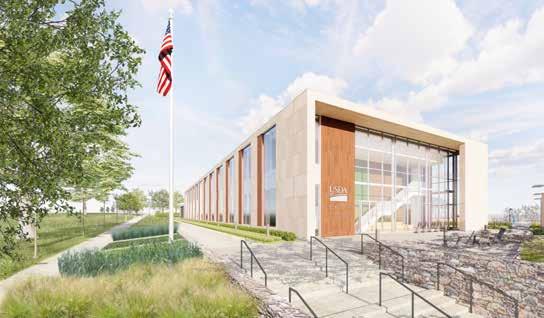
partnership with UK and Eden Shale Farm. FAPRU has conducted significant research there since the Kentucky Beef Network took over the farm’s operations in 2013. Notable accomplishments include chemical seedhead suppression of tall fescue, testing the effects of isoflavones on fescue toxicosis, and strategic summer supplementation of market cows. These collaborative efforts have resulted in valuable advancements in cattle management and health.
While the new lab will not have animal facilities, it will feature stateof-the-art greenhouses, enabling advanced plant and soil research. The absence of farm facilities highlights the continued importance of the research relationships between KBN, FAPRU and UK. This collaboration ensures that cattle-related studies can be conducted at UK research farms and Eden Shale Farm, maintaining a strong focus on practical, real-world applications.
FAPRU's mission is to improve the sustainability and profitability of forage-based livestock enterprises. The new building aligns perfectly with
this mission, providing a conducive environment for innovative research that addresses the pressing needs of the cattle community. By fostering interdisciplinary collaboration and leveraging the strengths of various research units, FAPRU is poised to make significant contributions to the cattle industry.
The development of the new FAPRU building is a positive step forward for the cattle community. By breaking down academic silos, enhancing collaborative research, and leveraging partnerships with UK and Eden Shale Farm, FAPRU is well-equipped to drive advancements in cattle research. This new facility represents a commitment to improving the sustainability and profitability of cattle enterprises, ensuring a bright future for the bovine industry.
The new FAPRU building will positively impact the cattle community by fostering interdisciplinary research, enhancing collaborative efforts and continuing valuable partnerships. This strategic move will advance the bovine industry, contributing to its growth and success for years to come.



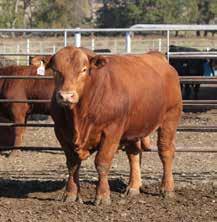
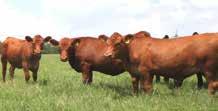
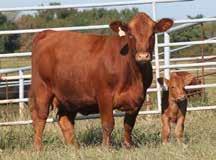
Generally the Buyer is responsible for collecting the Beef Checkoff assessment from the Seller

However, both the Buyer and the Seller are responsible for seeing that the Checkoff is collected and paid. or pays $2 to
QUALIFIED STATE BEEF COUNCIL
Cattlemen’s Beef Board invests in national Checkoff programs, while Kentucky Beef Council invests in state programs.
If you are a producer from one of these seven states - Alaska, Connecticut, Maine, Maryland, Massachusetts, New Hampshire, and Rhode Island - you will remit directly to the Cattlemen’s Beef Board. If you have any questions regarding who is responsible for remitting the Checkoff assessment or how to remit payment, please contact your State Beef Council or the Cattlemen’s Beef Board at (303) 867-6304.
3 Exceptions to Beef Checkoff Collection: 1. Non-producer status: If a person (or company) owns cattle for 10 days or less, purchases the cattle to facilitate the transfer of ownership to a third party, and certifies that any Checkoff dollars due from the previous owner have been collected, then that person qualifies as a “Non-Producer” and the Checkoff assessment is not due when qualified cattle are resold. 2. Organic Exemption: In the 2002 Farm Bill, Congress created a process exemptiing organic producers from paying Checkoff program assessments. 3. Pre-Payment: Producers can also choose to “prepay” the Checkoff assessment when shipping cattle out of state for feeding and still retain ownership on the cattle. This allows the producer to direct half of the $1-per-head national Checkoff assessment to the beef council in the state where the cattle were raised, rather than the state where the cattle will be fed. Note: To claim any of these exemptions, the person selling the cattle must provide the proper ‘document’ to show that the Checkoff assessment is not due at the time of sale. Thus, the rule of thumb for all cattle sales is that the person paying the producer should collect either a “Dollar or a Document.”
LIVESTOCK MARKET - When cattle are sold through a livestock market or video market, the Market collects and remits the Beef Checkoff assessment.
CATTLE DEALER/ORDER BUYER - When cattle are sold to a Cattle Dealer or Order Buyer, the Dealer/Order Buyer collects and remits the Beef Checkoff assessment.
ANOTHER PRODUCER - Both the Buyer and the Seller are responsible for making sure that the Beef Checkoff assessment is collected and remitted. For clarity and consistency, we encourage the Seller to take on this compliance responsibility.
VEAL GROWER - When dairy calves are sold to a Veal Grower, both the Buyer and the Seller are responsible for making sure that the Beef Checkoff assessment is collected and remitted. For clarity and consistency, we encourage the Seller to take on this compliance responsibility.
CATTLE SHOWS AND FAIRS - When producers sell their animals at fairs or cattle shows (4H/FFA shows, Purebred cattle shows, etc.), the Organization that runs the sale collects and remits the Beef Checkoff assessment.
FEEDLOT - When cattle are sold directy to a feedlot, the Feedlot collects and remits the Beef Checkoff assessment.
PACKING PLANT - When cattle are sold to a packing plant, the Packing Plant collects and remits the Beef Checkoff assessment.
DIRECT-TO-CONSUMER BEEF SALES - When producers market their cattle as beef, the Producer is responsible for remitting the Beef Checkoff assessment.
According to the Paperwork Reduction Act of
an agency may not conduct or
person is
to a
it
to
The
for this
of
and
control
OMB control
collection is 0581-0093. The time required to complete this
collection is estimated to
per response, including the
one
for reviewing instructions, searching existing data sources, gathering and
the
and completing and reviewing the
of
The U.S. Department of Agriculture (USDA) prohibits discrimination in all its programs and activities on the basis of race, color, national origin, age, disability, and where applicable, sex, marital status, familial status, parental status, religion, sexual orientation, genetic information, political beliefs, reprisal, or because all or part of an individual’s income is derived from any public assistance program. (Not all prohibited bases apply to all programs.) Persons with disabilities who require alternative means for communication of program information (Braille, large print, audiotape, etc.) should contact USDA’s TARGET Center at (202) 720-2600 (voice and TDD). To file a complaint of discrimination, write to USDA, Director, Office of Civil Rights, 1400
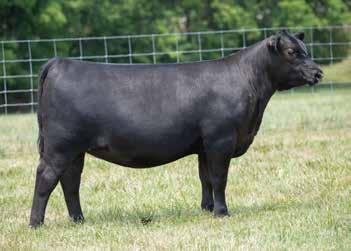


BOYD LADY 9127

growth figures in this impressive Growth Fund daughter –She sells safe to Boyd Bedrock and has a heifer calf at side by Sitz Domain!

• Donors
• Fall Pairs
• Elite Heifer Calves
BOYD ROSETTA 3401
• Spring Pairs
• Embryos

This maternal sister to Boyd Bellringer sells, sired by Yon Chattooga and safe in calf to S Armtrong. Also selling will be maternal sister by Sitz Resilient!

NOON (EST) // MAYS LICK, KY SATURDAY, SEPTEMBER 28, 2024 CALL OR EMAIL TO REQUEST A SALE BOOK!
The dam of Boyd Justification, one of the most popular bulls in the Genex line-up. She sells in her entirety, along with embryos sired by Boyd Bedrock and she has maternal sister selling by Sitz Accomplishment and Connealy Guard Rail! BOYD

7-21, 2024
The best livestock is coming to Louisville. Be a part of the greatest livestock event in the world.
ENTRY DEADLINE: OCTOBER 8



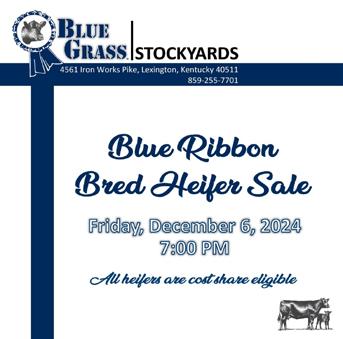

KY Simmental Association Sale September 28 1:00 PM
Horse Sale October 5 2:00 PM
Kentucky Stud Wagyu October 11-12
Millenium Longhorn October 18-19
Southeast Gelbvieh Alliance Sale October 26 1:00 PM
Trick or Treat at the Yards October 31—6:00 PM
Profit Thru Performance Feeder Sale December 4—6:00 PM
Blue Ribbon Bred Heifer Sale December 6 7:00 PM
Kentucky Hereford Association Sale December 7 1:00 PM
Kentucky Certified Hereford Influence Sale December 12 6:00 PM
Christmas Pony Sale December 14 2:00 PM
Holstein Sale September 21 1:00 PM
BG SOUTH
Next Generation Bred Heifer Sale November 16—1:00 PM
Charolais Influence Feeder Sale
December 12
Katie Pratt Kentucky Cattlemen's Association
Like many Kentucky beef producers, the work day doesn’t end for University of Kentucky assistant professors Josh Jackson and Morgan Hayes at 5 p.m. Jackson and Hayes are also cattle farmers in addition to their daytime jobs as agricultural engineers.
The son of two animal scientists and dairy farmers, Jackson grew up on his family farm in Mercer County. At 8 years old, he got his first half-Holstein, half-Angus show heifer and began spending a good amount of time in the show ring.
Jackson received all of his degrees from UK. Today, Jackson and his wife Rebecca Delles, a meat scientist at AllTech, have a cow-calf operation of around 60 mama cows in Mercer County. Their herd includes registered Angus and a Holstein-Angus mix.
Raised in a Philadelphia suburb, Hayes comes from a family of engineers. She decided to


become an agricultural engineer because of her love of animals. She earned her bachelor’s degree at Penn State before moving to Kentucky to continue her education.
Today, she raises around 100 mama cows in her Saler-based operation with her husband W.D. King in Boyle County. They also raise a few animals for freezer beef and run a custom hay operation.
Long before their professional career paths crossed, Jackson and Hayes met as students at UK. Hayes was pursuing her master’s and Jackson was in his final year of his bachelor’s degree when they met in a senior level beef production class taught by Fred Thrift. Hayes’ husband was also in the class.
After earning her master’s, Hayes left Kentucky to pursue her doctorate at Iowa State. She then had a post-doctoral appointment with the U.S. Department of Agriculture, Animal Research Service’s U.S. Meat Animal Research Center in Nebraska and worked as an assistant professor at the University of Illinois before returning to Kentucky in 2016.
At UK, both have extension appointments in livestock systems but in different capacities. Hayes focuses mostly on animals in barns or confinement. Jackson is focused more on animals on pastures and drone applications. Their duties overlap on handling facilities and farm layout.
Having their own cattle operations helps them better understand the producers they work with at UK.
“It’s one thing to say what you should do and it’s another thing to get out there and do it,” Jackson said. “I’ve really focused a lot on low-cost systems. It’s easy to say spend a lot of money and you’ll improve your operation. As a farmer, I don’t want to spend a lot of money or I can’t spend a lot of money.”
In 2021, they started a podcast called “Have You Herd?”. It allowed them to share their experiences as farmers and engineers with a larger audience. They produce around 40 episodes a year.
“We both believe in rotational grazing, working calves and keeping records,” Hayes said. “We know it’s hard having full-time jobs off the farm. We try to choose a timely topic each week, give our engineering perspective and then talk about our weekly goals with our own farming operations.”
While each runs their own farm, they do occasionally call on each other for help.
“We’ve built a number of hoop barns together,” Hayes said. “It’s nice to know there is someone around if you need help or have a question.”
“It’s also nice if I need to borrow a wagon or a trailer, I know I can call her,” Jackson said.

Kayla Brashears KFBM Area Extension Specialist
Several years ago, I wrote an article for the Economic & Policy Update, “What to do When You Have Too Much Money.” We’re having a full circle moment due to the volatility of the agriculture industry as Kentucky farms are experiencing a slide in profitability from the booming 2020, 2021 and 2022 crop years. Many of the farms I work with are feeling pressured as their working capital has been cut in half (or worse). Understandably, seeing a negative net farm income in 2023, or the ceiling of your operating line approach as the stack of bills on the desk grows is panic inducing. It’s important to remain level-headed as the farm enters a season of tightening cash flow. I’ve outlined a few actions below to help.
A dire position a farm never wants to find themselves in is realizing they do not have the cash on hand to make the week’s payroll. This is a BIG problem and must be avoided at all costs. You must be aware of the cash you have available to meet your immediate obligations. Develop a list of your expected costs each month and order them from rigid to flexible. Some obligations are rigid: payroll, utilities, many services. Others may have more flexibility, like allowing you to make a minimum payment or even shift the payable to a longer financing term – crop and feed input suppliers are an excellent example of this. They will often allow a farm to make a minimum payment on their payable until the crop comes in. On

the income side, include a prediction for all avenues of income. Livestock sales, crop sales, patronage dividend, rents, etc. Do the math to be sure you will have the cash on hand to meet your obligations.
Despite years of planning and attempts, farmers haven’t developed a way to manipulate the weather or commodity markets to their whims. They can, however, manage their expenses with more precision. When funds are tight, careful evaluation of crop fertility plans, maintenance schedules, labor needs and all other operations are necessary. It takes an experienced farmer to develop a plan. It’s possible to starve your profit by skimming on fertilizer, as an example. A focus on efficiency is important, and a harder look may reveal easy to achieve methods that could save you serious cash. Be proactive about collecting settlement checks to stop the interest on the operating line of credit. Utilize floating accounts to buy yourself an interest-free 30 days. Repair your cattle chute instead of buying new and review your insurance policy to be sure you aren’t paying insurance on equipment you sold three years ago. (It happens!)
If you’ve reduced expenses and developed a cash flow, and the numbers are coming up short, it’s time to explore your options. One of the most common cash flow solutions, refinancing, may be off the table due to rising interest rates,
as KFBM specialist Jennifer Rogers addressed in her article, “Interest Rates and Refinancing.” A refinance is worth exploring with your banker because every situation is unique and there may be an option for you. Other options include pursuing offfarm income to alleviate demands of the farm for family living expenses or even asset liquidation. Every farm has different resources, and it’s best to speak with a neutral third party like your accountant or KFBM specialist to help you navigate your situation.
Be Honest with Yourself and Your Lenders
Farms have been through the cycle of drastically reduced farm income for, literally, decades. Those that survived it never tried to run from it. A down year, a failed marketing plan, record-breaking submerging rainfall, or a late, crop-stunting freeze are not markers of a poor farm manager. The belief that only bad farmers experience cash flow problems could prevent you from seeking the help you need to correct the problem. The bank wants to see you remain profitable and pay your debt obligations. If you are upfront about your liquidity issues, they may be able to help or, at a minimum, offer understanding until the ag industry improves and your problems ease. Plummeting commodity markets, significant weather events and input inflation are intimidating problems. But – you do not have to face them alone.

Synovex ® Primer™ is the new low-dosage implant containing trenbolone acetate (TBA) and estradiol benzoate for use in growing beef steers and heifers in the dry lot. Implants such as Synovex Primer help producers increase their throughput with more weight gained in the dry lot period before they move cattle to pasture or the confined feeding space.
In a summary of Food and Drug Administration documents, dry lot is defined by these four criteria: diet, environment, growth expectations and cattle moving to the next phase in the production cycle.
Cattle receive the majority of their diet from harvested forage/roughage with minimal supplementation. Cattle may be reared on dormant pastures and/or housed in dirt floor pens.
Growth expectations are consistent with those typically observed in cattle on pasture.
From this phase, cattle may move to a pasture or feedlot management setting.
Synovex Primer is a low-dosage combination product containing 50 mg of TBA and 7 mg of estradiol benzoate to encourage efficient use of feedstuffs and help cattle add weight faster. Synovex Primer significantly increased average daily gain (ADG) compared with the sham implanted group, 2.47 vs. 2.21 lb./head/ day ( p = 0.0016) over the course of a 90-day study.1
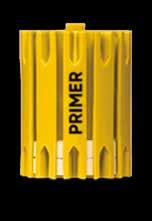
Implants, such as Synovex Primer, allow dry lot producers to increase their throughput if they are increasing weight gain at a faster rate. Increased gain can result in lower cost of gain. With the addition of Synovex Primer to the Zoetis portfolio of implants, producers can now dial in the TBA and estradiol benzoate dosage dosage over the animal’s lifetime to match the right Synovex implant to the available nutrition and performance goals.
Processing is more efficient, because Synovex Primer is designed for use with the Synovex EXACT10 ® and The Revolver applicators. The same implant can be used in beef steers and heifers, simplifying inventory.
Consider what an implant containing TBA, such as Synovex Primer, offers your operation. Increases ADG in the dry lot.1
Extends the growth curve and keeps cattle leaner longer. 2 Helps turn cattle quicker because weight is gained faster.
Synovex Primer helps complete the most comprehensive lineup of implants across all production phases in the industry. 3 The implant portfolio is just one part of what Zoetis offers dry lot producers, including antibiotics, vaccines and parasite control.
Refer to individual labels for complete directions for use, precautions, and warnings. Reimplant only if and as directed in labeling. Get more information, including details about best-in-class service with chuteside training, and nutritionist, veterinary and technical support from Zoetis, at Synovex.com.
1 Synovex Choice and Synovex Primer Freedom of Information (FOI) Summary, NADA 141-043.
2 Smerchek DT, Smith ZK. Effects of increasing doses of trenbolone acetate and estradiol on finishing phase growth performance, carcass trait responses, and serum metabolites in beef steers following implantation. Transl Anim Sci. 2020;4(3):1-8. 3 Based on comparison of approved implants available in each production phase currently marketed by Zoetis, Merck and Elanco.
Proactive planning grows grass and reduces unwanted weeds. Schedule fall application between late October and the first true frost to make the biggest impact on your grazing spaces. Spring rains can interfere with conventional spray treatment; get a jumpstart on forage production with fall herbicide application.
RECOMMENDED PRODUCTS:
Gunslinger® AMP, Prescott, Grassmaster™

buttercup, thistle, henbit, deadnettle, chicory, plantain
@Alligare, LLC
@Alligare.IVM
Alligare.com

Presented by Bourbon County Livestock Improvement Association www.eliteheifer.com Virtual Sale Available (Download Form on Website)
Monday, November 4, 2024
Sale 6:00 PM E.D.T.
Paris Stockyard- US 68 North Inspection 1:00-5:00 PM E.D.T.


Approximately 300 heifers available - approximately 150 AI (Angus & Angus X, Charolais X, Simmental X, Red Angus)
All heifers calfhood vaccinated
All heifers have tested negative for BVD, PI
Sale lots will be grouped to calve in 45 days
Lots can be viewed online at www.eliteheifer.com
SELLING 225 SPRING CALVING BRED HEIFERS
All heifers are guaranteed bred to bulls with known EPDs and have met stringe requirements for health, quality and pelvic measurements.
All heifers are guaranted bred to bulls with known EPDs and have met stringent

Heifers bred to calving ease bulls with EPD’s available, some bred AI
Heifers have met minimum pelvic measurement requirements
Heifers have met target weight requirements for their breed types
Fall health work completed (Bovi Shield Gold 5 FPL5 & Pour-on wormer, 45 days before sale)
All heifers meet Large or Medium frame
No shorts, bad eyes, no horns, no rat tails (Inspected by Ky Dept of Ag)
All heifers are Source Verified AND Electronically Identified
FREE DELIVERY OF 10 OR MORE HEAD, UP TO 500 MILES
Heifers owned and managed under Elite Heifer guidelines since 12/1/2023
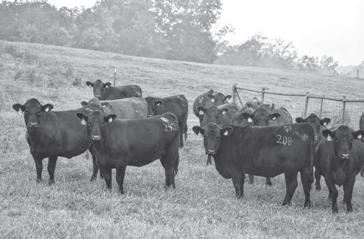
All heifers guaranteed pregnant 60 days post sale. Heifers may be palpated by a licensed veterinarian up to 60 days post sale and buyer be refunded $5.00/head for heifers palpated
Heifers qualify for CAIP Program Sponsored by:
KENTUCKY-TENNESSEE LIVESTOCK MARKET GUTHRIE, KENTUCKY SATURDAY, NOVEMBER 23, 2024 12:00 NOON CENTRAL TIME

The right time is now. The right way is
Thanks to the partnership between Kentucky Beef Network and University of Kentucky get FREE BQCA CERTIFICATION on line or through your county extension office September 1st through September 30th, 2024.
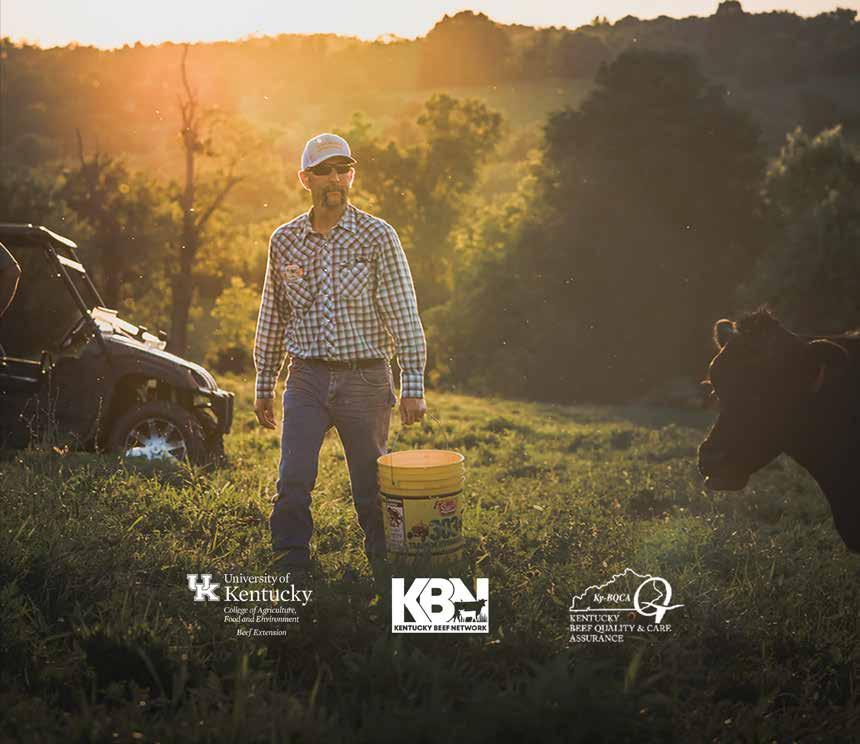

The 2025 KCA Membership year will run October 1, 2024 - September 30, 2025. Renew early to enjoy the full benefits of membership and to avoid interruption of your Cow Country delivery! Congratulations on another
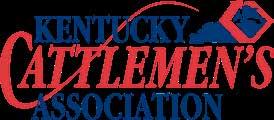
* MEMBERSHIP YEAR 10/1/24– 9/30/25
NAME SPOUSE NAME FARM NAME
*Payments of KCA membership dues are tax deductible for most members as an ordinary and necessary business expense. However, charitable contributions of gifts to KCA are not tax deductible for Federal Income Tax purposes. Due to new IRS regulations, $2.24 of your dues would not be deductible. Approximately $12 of your dues will go towards the monthly publication Cow Country.
PLEASE CHECK THE MEMBERSHIP(S) YOU WOULD LIKE TO JOIN:
KCA MEMBERSHIP ($30/YR) NEW RENEWAL
Membership dues are $30 unless otherwise listed below
KCA COUPLE MEMBERSHIP
To add your spouse, please add $15 to your KCA Membership
KENTUCKY JUNIOR CATTLEMEN’S ASSOCIATION ($10/YR) NEW RENEWAL
I WOULD LIKE ADDITIONAL INFORMATION ON THE YOUNG PRODUCER’S COUNCIL
TOTAL MEMBERSHIP:
$ KCA
$ KJCA
TOTAL CONTRIBUTIONS:
$ CATTLEMEN’S FOUNDATION DONATION (voluntary)
TOTAL AMOUNT ENCLOSED:
$ ALL DONATIONS TO KCF ARE TAX DEDUCTIBLE
COUNTY DUES
Dues are $30 except for the counties listed below.
Allen...............................$40
Anderson........................$25
Bourbon.........................$20
Boyle ..............................$35
Bullitt..............................$20
Butler..............................$25
Franklin ..........................$25
Louisville Area ................$20 (Jefferson, & Spencer) Magoffin .........................$20 Menifee ..........................$25
Mountain........................$25
(Breathitt, Floyd, Knott, Lee, Leslie, Letcher, Morgan, Owsley, Perry & Wolfe)
Highlands .......................$20 (Boyd, Johnson, Lawrence, & Martin) Hopkins ..........................$35 Laurel.............................$35
Woodford......................$25
IF YOU WOULD ALSO LIKE TO JOIN THE NATIONAL CATTLEMEN’S BEEF ASSOCIATION The NCBA is now a State Marketing Partner with the KCA. You can pay your dues to both organizations with one check, at the same time.
+
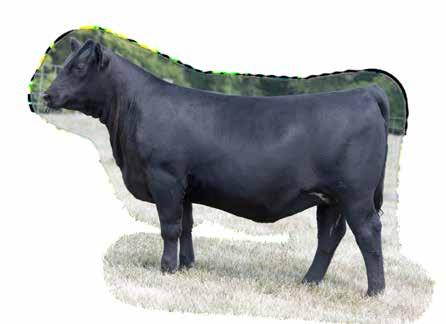
• Every Three-Year-Old Female Sells • Cow-Calf Pairs
• ET Heifer Calves • Featured Donor Females
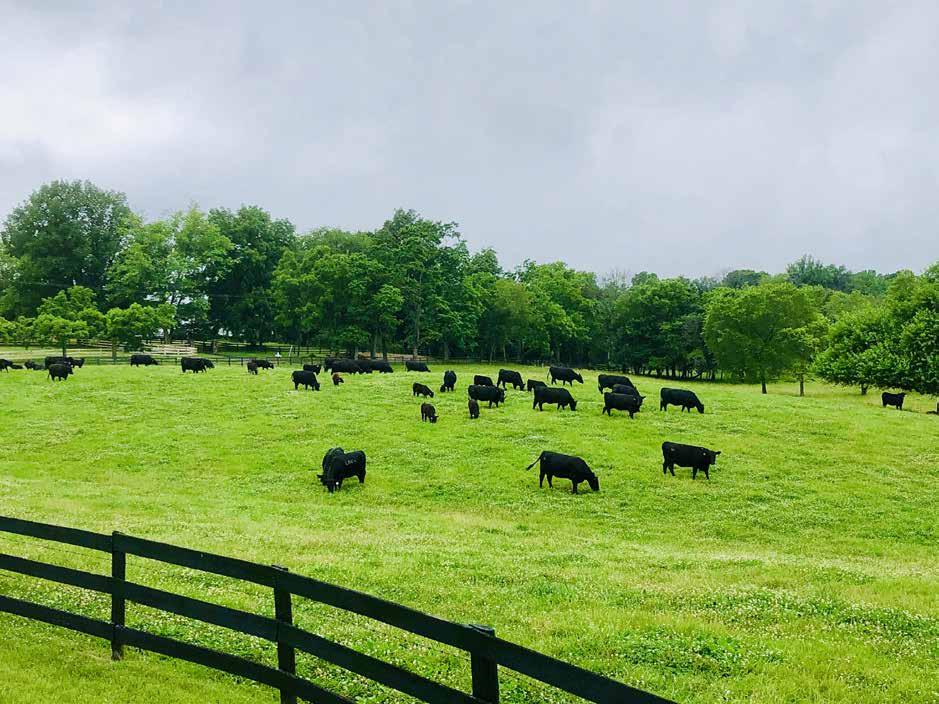
Whitestone Pride 4002

Whitestone Everelda 4007
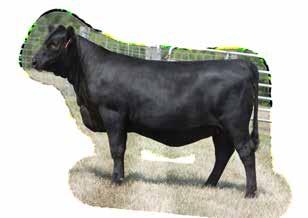
A great breeding piece for any program with all the bells and whistles needed to take your program to the next level.
Whitestone Everelda 4014
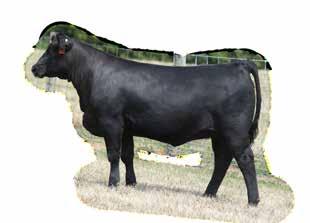
Please


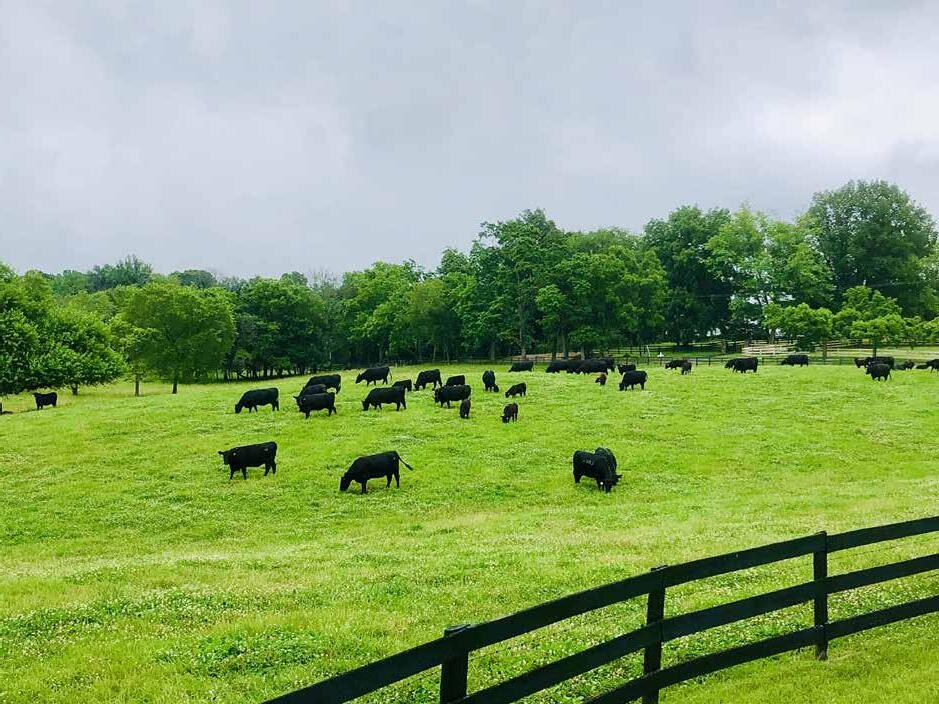


Bradon Burks Director of Education
From July 29 to Aug. 1, the Kentucky Beef Council hosted 29 of the brightest young people through its Youth Leadership Program. Through this program, we provided our attendees with a week full of connections, leadership development and career outlook opportunities for all aspects of the beef industry. From cattle production to beef processing, it was a fun-filled beef week!
The week started with a program by Dr. Kimberley Heller, lead consultant for Vezeto Leadership Consulting and the director of education for the Red Angus Association of America. Dr. Heller provided an exceptional training focused on developing the leadership skills needed to be successful within the beef industry. Exercises like this are a great way to “break the ice” amongst the group and jumpstart their thinking about how they can be a part of the industry. The next day, we focused on promotion for both consumer and producer facing aspects. That morning started with an overview of the Beef Checkoff, nutritional information with beef, social media tips and a session on the flavor profiling of beef. Todd Brown and Danny Coy of the Kentucky Cattlemen’s Association provided attendees with a one-of-akind experience on food staging for photography sessions. The participants created a burger that had a balanced flavor profile and took a high-quality image that could be used in various
magazines or social media posts. That afternoon, we visited Adams Family Farm (Matt and Molly Adams) and Pepper’s Hardin County Milling (Matthew Morgan). They provided great advice on how they develop personal relationships with their customers. That evening, we hosted a dinner and keynote with Terry Burks, a nationally renowned livestock judge. Terry never ceases to amaze me with his power of storytelling and inspiring groups to go above and beyond the call of duty.
The third day was focused on end product, including lessons on beef grading with Donovan Pigg, marketing specialist with Kentucky Farm Bureau, and beef alternative merchandising with Gregg Rentfrow, University of Kentucky meat scientist. This was a great chance to expose our youth to meat science opportunities, and the group really seemed to be engaged and took a lot away from these sessions. That afternoon, we toured Green River Meats in Campbellsville. Co-owner Tim Jeffries shared with our group about the steps of processing beef and providing a product that their customers want. We were also able to visit co-owner Dr. Randy Smoot’s new finishing lot. We don’t seem to finish many cattle in Kentucky, so seeing finishing facility in the Bluegrass was a unique opportunity.
Our final day was full of cattle knowledge, including sessions on understanding feeder cattle markets with Jackson
Tolle, business development manager with United Producers Inc.’s Livestock Marketing division, an artificial insemination lab with Kentucky Beef Network facilitator Ben Lloyd, and an embryo transfer lab with Veterinarian Dr. Levi Holt and Scott Burks, embryo technician with Green River Embryo Transfer. Students were so engaged with these sessions and asked so many valuable questions. Lunchtime included an etiquette dinner training with Sullivan University where we learned all of the do’s and don’ts for formal dining experiences. We also hosted UK Animal Sciences Professor Darrh Bullock and Eddie Burks, auctioneer, who conducted an EPD lesson and a mock bull auction. This gave the group an opportunity to get training on buying bulls. We wrapped up the evening with a networking dinner with some of the state's finest beef industry leaders. It was truly an incredible opportunity for our youth to hear from the state's best leaders in the beef industry.
I would like to say thank you to my KBC colleagues Alex Scott and Kelly Baird, all of our speakers, and hosts for creating such an exceptional opportunity for our youth. The commitment to the future of the beef industry is crucial for its ongoing success. I’m also grateful to our producers for their trust in me to cultivate the next generation of beef leaders. I look forward to planning our next youth development event soon.

Anna Chaliff Rockcastle County
Anne Claire Garmon Barren County
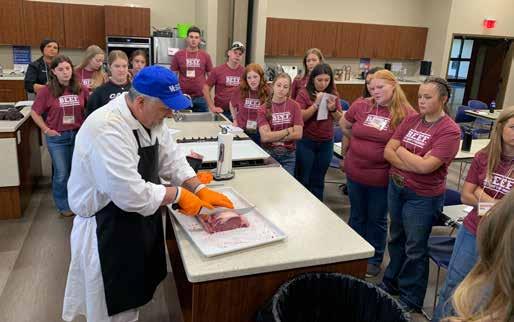

Avery Chapman Barren County
Avery Drane Breckinridge County
Brooklyn Felts Nicholas County
Cadence Kerr Scott County
Cailey Divine Union County
Callie Derossett Henry County
Clara Belle Bishop Nelson County
Creighton Smith Scott County
Cyrus Bivens LaRue County
Ella Smallwood Menifee County
Elly Hampton Hopkins County
Emily Pike Nelson County
Halle Hudnall Scott County
Holland Kelsay Barren County
Jennie Watts Christian County
Kaitlyn Keith Taylor County
Kyra Moore Barren County
Landon Miller Nelson County
Lauren Ellington Montgomery County
Lexie Garrett Nicholas County
Lillian Darr Muhlenberg County
Matthew Estes Barren County
Mavrick Keister Mclean County
Mollie Goode Christian County
Sahara Peterson Christian County
Samantha Pecco Fleming County
Tyler Hibbard Laurel County

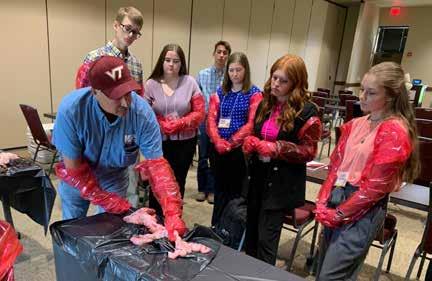


Jake Harrod Program Coordinator, Kentucky Beef Network
Throughout my life, I have heard people say, “You can’t teach an old dog new tricks.” This means that once you learn something, you will do it that one way forever. This could not be further than the truth for cattle farmers. Learning, listening and adapting are some of a producer’s greatest tools. The cattle industry is constantly changing as a result of consumer preferences, new innovations and improved methods. Learning and improving is something that all of us must do.
Constant improvement has been at the heart of the mission of Eden Shale Farm. When the Kentucky Beef Network took over the management of Eden Shale Farm in 2013, the goal was to educate cattlemen using a hands-on approach. On the farm, they use many Beef Quality and Care Assurance (BQCA) practices to help guide how the farm operates. The care aspect of BQCA involves keeping the health, safety and well-being of your animals at the forefront of your mind. This involves not only how you handle your animals but also their surroundings and resources, such as the waterers they drink from, where they eat hay or go for shade.
Additionally, Eden Shale Farm is known for its many features that have been improved upon or built to help educate cattlemen that visit the farm. One of features is the calving barn. This barn was renovated and improved upon from literally the ground up. The floor was dug down to solid soil and then a layer of geotextile filter fabric was added followed by 6 inches of dense grade aggregate. Then, geogrid interlocking pieces were added and backfilled with dense grade aggregate. Finally, a top layer of wood shavings was added. This created a floor that is very easy for the cattle to walk on and improved drainage in the facility. Since moisture more easily drains out that means mud does not develop on the surface, and even if there is an abundance of moisture, the cattle still have solid footing. Furthermore, bedding in there lasts much longer. Giving cattle a dry, shaded space can help greatly improve productivity and reduce sickness.
Tire waterers are one of the most popular features of Eden Shale Farm. Throughout the farm, there are various versions of the beloved waterers. A tire-tank waterer can typically hold 500-800 gallons,
depending on the size of the tire. A larger diameter means more livestock can drink at one time (e.g., 10-16 head versus one to two for automatic water fountains). Tire waterers help fix a multitude of problems that can occur when only one or a few animals can drink at a time. These issues include aggressiveness, congestion around the waterer, increased heat from animals in close proximity to one another and reduced water intake. Additionally, cattle like to drink in groups, and this gives them the ability to do so. Adding a tire waterer can help keep cattle in better condition, more content, better hydrated and satisfied.
Making sure to incorporate care into your operation is one of the best steps you can take to improve the productivity and well-being of your animals. It can be added to every facet of your farm. From the waterers they drink from, where they go to get shade or the facilities where you work them. And if you need a couple ideas to get started, you can plan to attend the Eden Shale Farm Open House on Oct.19 or you can check out the resources page on the Eden Shale Farm website www.edenshalefarm. com.



Dan Miller Industry Coordinator, Kentucky Beef Network
It was a beautiful spring morning on Derby Day 2013 when I drove to Eden Shale Farm to take delivery on what would become the Kentucky Beef Network’s commercial cow herd. I’ll never forget the six gooseneck trailers lined up in front of the barn waiting to unload.
If you remember, we purchased those cattle out of stockyards from all across Kentucky. There were a few good cows mixed in among them, but most of them were just rough ol’ cows. If you happened to attend our first Open House that year, you remember what I am talking about. We had a big job in front of us to get the cows culled back to a productive set of females, all while keeping enough calves in the herd to pay the bills. Those first five years were certainly a challenge. The second year alone we had a 47% cull rate in the herd!
With the help of Genetics Plus, we started an AI program in 2015 and exposed all the cows to one round of timed AI. This gave us the opportunity to introduce much better genetics into our herd, and it allowed
to stay in the herd regardless of her performance because we needed warm bodies to create calves. We have continued to AI every spring and have now developed a much tighter calving window. This year we had every calf except for two stragglers born in 49 days, a big improvement over the 105-day calving season we had the first year.
Keeping and developing our own replacement heifers every year has allowed us to settle into a stable, young herd of cows that continues to get better with each AI selection. We have grown to 100 head of mature cows, and we develop roughly 25-40 of our own heifers each year. During this expansion process, we have also been able to increase our weaning weights while lowering our mature cow weight at weaning. Our cows are now weaning 42% of their body weight on average, a number that is also slowly rising. While we still have a lot of work to do with our cow herd, we have come a long way from that first set of cows that were delivered in 2013.
Another component that we have improved is our cattle infrastructure.
have attended a tour at the farm, you should have noticed that his influence is everywhere. We have completely changed our winter management to the extent that we pull the cows up to 125 acres to do all our winter feeding, yet we do not tear up our sod pastures and no renovations are required in the spring. Also, we are able to feed all our winter hay without the tractor veering off the gravel farm road. Implementing these management practices has eliminated any newborn calf death loss due to mud, scours or trampling at a hay ring, which is a massive improvement from our first three winters.
This infrastructure has also been the topic of numerous farm tours over the last decade. In a normal year, we host about 40 tours and events at the farm. These tours range in participants from Kentucky producers, regulatory agencies and even international travelers. The Eden Shale Farm has given the Kentucky Cattlemen’s Association an avenue of outreach and education that would not be possible in an office setting. I want to thank our board of directors for giving me the opportunity to operate






KEVIN AND RACHEL BARRON
Crestwood, Ky
(502) 905-5851
rkbarron812@gmail.com
SWAIN SELECT SIMMENTAL 12113 Green Valley Dr. Louisville, KY 40243


swainselect.com swainselect@gmail.com facebook.com/swainselectsimmental
Fred & Phyllis: 502-599-4560 Chi & Angie: 502-287-2116

JUDY AND RONDAL DAWSON
1156 Buzzard Roost Road Shelbyville, KY 40065 502-593-5136 • jrdawson22@outlook.com

JEROD METZGER • 270-779-6260

ROCKING P LIVESTOCK 8308 Orangeburg Road Maysville, KY 41056
Chan: 606-584-7581
Keith: 606-584-5626
rockingplivestock@maysvilleky.net
BRIAN & HEATHER SWAIN 3906 Pottertown Road Murray, KY 42071 • 270-293-4440
wksbswain@murray-ky.net


SIMMENTAL AND SIMANGUS BULLS FOR SALE
1939 Huntertown Road
Versailles, KY 40383
BULLS FOR SALE
Chris Allen 859-351-4486
callenuky@hotmail.com
Dr. Henry Allen 859-229-0755


Modern-day ranching requires more information to produce better animals. International Genetic Solutions works across breeds to provide more accurate head-to-head comparisons and maximum profitability.
IGS incorporates generations of data and the world’s largest multi-breed database to enable more powerful breeding decisions than ever before.
Better cattle. Better profits.

BRET AND LAURA JACKSON 859.533.3718 or 859.707.7200
BRET & LAURA JACKSON Paris, Kentucky (859) 533-3718 (859) 707-7200

BOYD BEEF CATTLE
6077 Helena Road
Mayslick, KY 41055
Charlie Boyd II: (606) 584-5194
Blake Boyd: (606) 375-3718 www.boydbeef.com cboyd2@maysvilleky.net
BURTON & SONS ANGUS
Joe D. or Karen Burton
BOYD BEEF CATTLE 6077 Helena Road Mayslick, KY
Secretary/Treasurer:

BRANCH VIEW ANGUS
927 Old Liberty Pike • Hustonville, KY 40437 (859) 238-0771 • www.branchviewangus.com
927 Old Liberty Pike • Hustonville, KY 40437 (859) 238-0771 • www.branchviewangus.com

480 Hominy Hill Rd. Nancy, KY 42544
Joe: (606) 305-3081
Located 15 miles West of Somerset • klburton01@windstream.net
Bulls & females sold private treaty. Inquiries Welcome. Sell only what we would buy. Data driven since 1981.
FALL CREEK ANGUS
448 Corder Farm Road
Monticello, KY 42633
Ronnie Corder (606) 348-6588
HILL VIEW FARMS
Jimmy Gilles
5160 Lee Rudy Road
Owensboro, KY 42301 (270) 929-5370 jcgilles86@gmail.com
OLD BARK FARM
370 Ferrill Hill, Buffalo, KY 42716
Kenley Conner (502) 905-7825
Registered Angus Cattle
ST. CLAIR FARMS REGISTERED ANGUS
Eric & Sherry St. Clair
13433 Falls of Rough Road Falls of Rough, KY 40119
Home: (270) 257-2965 • Cell: (270) 617-1079 www.stclairangus.com
Performance Tested Bull & Female Sale April 2020

TWIN CREEK FARM
HILL VIEW FARMS
Shawn, Melissa, Devin & Dylan Gibson (270) 337-3072 or (270) 692-5304 Dennis & Emily 270/337-2128 or 270/402-4338
Jimmy Gilles 5160 Lee Rudy Road Owensboro, KY 42301 (270) 929-5370 jcgilles86@gmail.com

42301 (270) 929-5370 jcgilles86@gmail.com

James S. & LuAnn Coffey, Donald & Donna Coffey
Annual Production Sale- 2nd Saturday in April
James S. & LuAnn Coffey, Donald & Donna Coffey Annual Production Sale- 2nd Saturday in April

COFFEY ANGUS FARMS
BURKS CATTLE CO. 531 Rick Rd. Park City, KY 42160
661 Hopewell Road Liberty, KY 42539
Eddie Burks • (270) 991-6398 www.burkscattle.com
Matt Coffey: (270) 799-6288
Dewey Coffey: (606) 706-2699
BURTON & SONS ANGUS
Genetics for Maximum Profitability since 1984
Joe D. or Karen Burton
480 Hominy Hill Rd. Nancy, KY 42544
Joe: (606) 305-3081

Located 15 miles West of Somerset • klburton01@windstream.net
Bulls & females sold private treaty. Inquiries Welcome. Sell only what we would buy. Data driven since 1981.
GREAT MEADOWS ANGUS ASSOCIATION
COFFEY ANGUS FARMS
661 Hopewell Road Liberty, KY 42539
Dale Brown, President 292 Pea Ridge Road Stamping Ground, KY 40439 859-940-8437 www.greatmeadowsangus.com
Matt Coffey: (270) 799-6288
Dewey Coffey: (606) 706-2699

Genetics for Maximum Profitability since 1984
DAVIS BEND FARMS
LYNN CREEK FARMS
2315 Davis Bend Road Canmer, KY 42722
Kris and Sara Lynn 2184 Bardstown Rd Springfield KY 40069 573-721-6663
timmothyljeffries@gmail.com www.davisbendfarms.com Tim: (270) 528-6605 • Leslie: (270) 528-6435

FALL CREEK ANGUS
APS ANGUS
448 Corder Farm Road Monticello, KY 42633
Ronnie Corder (606) 348-6588
4040 Taylorsville Rd Taylorsville, KY 40071
Gordon Schubert
502-477-2637 • 502-548-8440
HAMILTON ANGUS FARMS

Anne Patton Schubert
502-477-2663 • 502-548-2359
Eddie Hamilton 2142 Stilesville Road Science Hill, KY 42553 edjohami@aol.com (606) 271-1286 Bulls and Females for Sale
TRIPLE D ANGUS
Nathaniel & Darla Denham
HERITAGE FARM

Nathaniel(Bub), Sarah, Ashley Denham (606) 423-2457 • (606) 875-0780 tripledangus.com
Tom McGinnis 1024 Hinkle Lane • Shelbyville, KY (502) 633-1634, home • (502) 633-5100, work (502) 655-0164, cell
PLEASANT HILL FARMS
PLEASANT HILL FARMS
Gil, Mary, Corbin, Caroline, and Catherine Cowles 500 Rockfield Richpond Road Rockfield, KY 42274 (270) 843-9021 • Fax (270) 843-9005
Gil, Mary, Corbin, Caroline, and Catherine Cowles 500 Rockfield Richpond Road Rockfield, KY 42274 (270) 843-9021 • Fax (270) 843-9005 Located 7 miles west of Bowling Green, 1/2
BURKS CATTLE CO. 531 Rick Rd. Park City, KY 42160
JOHNSON FARMS ANGUS
Angus Bulls & Females Slaughters, KY
Keith: (270) 635-0723
Eddie Burks • (270) 991-6398 www.burkscattle.com
Reese: (270) 635-1137
LYNN CREEK FARMS

DUTCH CREEK ANGUS FORAGE GENETICS
Kris and Sara Lynn 2184 Bardstown Rd Springfield KY 40069 573-721-6663
Doug and Susan Schlosnagle (502) 706-0008 DutchCreekAngus.om
MT. MORIAH ANGUS FARMS
Bob, Kathy, Rob, and Janna Clark (859) 748-5558 1446 Kennedy Bridge Rd. Harrodsburg, KY 40330 Bob: (859)339-2610 • Rob: (859)612-1594 mtmoriahfarms1@gmail.com www.mtmoriahangus.com
HERITAGE FARM
Tom McGinnis
1024 Hinkle Lane • Shelbyville, KY (502) 633-1634, home (502) 633-5100, work (502) 655-0164, cell
FOUR KINGS ANGUS
250 Bright Leaf Dr. • Harrodsburg, KY 40330
Cary & Kim King Carymking@yahoo.com • fourkingsangus.com

Jacob
Owner-Operator (859) 583-7134 jacob.tamme@gmail.com www.tammevalley.com

Cary Cell: (859) 613-3734 • Colby Myers - Purebred
MT. MORIAH ANGUS FARMS
OLD BARK FARM
370 Ferrill Hill, Buffalo, KY 42716
Kenley Conner (502) 905-7825
Registered Angus Cattle
Bob, Kathy, Rob, and Janna Clark (859) 748-5558 1446 Kennedy Bridge Rd. Harrodsburg, KY 40330 Bob: (859)339-2610 Rob: (859)612-1594 mtmoriahfarms1@gmail.com www.mtmoriahangus.com
Nathaniel(Bub), Sarah, (606) 423-2457 • (606) tripledangus.com

TWIN CREEK FARM Shawn, Melissa, Devin (270) 337-3072 or (270) Dennis & Emily 270/337-2128 or 270/402-4338
SMITHLAND ANGUS FARM
4437 East Hwy 80 Russell Springs, KY 42642
4040 Taylorsville Rd Taylorsville, KY 40071 Gordon Schubert 502-477-2637 • 502-548-8440 Anne Patton Schubert 502-477-2663 • 502-548-2359
Henry Bryan, Melissa, Bryanna and Blane Smith 606-271-7520 bmsmith@duo-county.com
WHITE FARM
Tim and Amy White 3664 Military Pike Lexington, KY 40513
Home: (859)223-0326
Tim: (859) 509-5401 Amy (859)227-2552 whitefarm4@twc.com

Located 7 miles west of Bowling Green, 1/2 mile off Hwy 68/80


Shayna Gibson, Secretary/Treasurer
www.kentuckyangus.org • kyangusassociation@gmail.com • @kyangusassoc
Tom McGinnis of Heritage Farm, Shelbyville, Ky., was recognized as an Honorary Angus Foundation Inductee for his support of youth programs.

for it.”
McGinnis has donated to the Angus Foundation’s Fund the Future, Day of Giving and Legacy Built campaigns. He has supported Leaders Engaged in Angus Development (LEAD) and Raising the Bar – youth development conferences for National Junior Angus Association (NJAA) members. McGinnis has also lent his support to foundation events at Cattlemen’s Congress and the not-for-profit organization’s annual golf tournament.
“Tom McGinnis gives unwavering support to the Angus Foundation, junior Angus members and the breed,” said Caitlyn Brandt, director of events and junior activities for the American Angus Association®. “His selfless commitment to the longevity of the breed and the Angus family makes him more than deserving of an Honorary Angus Foundation induction.”
Kentucky Angus breeder, Tom McGinnis is a man of few words and one who is not eager to be recognized for his generosity. But for decades, he and his family have illustrated their passion for supporting the next generation of leaders in agriculture through their actions.
“I’ve just always wanted to help the youth connected with the Angus breed and really youth in general,” said McGinnis. “The young people, they are our business in the future. I think anything we can do to help them along; everyone needs to be a part of that.”
The Shelbyville, Kentucky, rancher grew up on a dairy farm, which he credits with teaching
These young men were the American Angus Auxiliary’s male scholarship winners at the 2024 National Junior Angus Show (NJAS) Awards Ceremony, July 6 in Madison, Wisconsin. Pictured from left are Drew Mickey, Taylorville, Indiana, first; Lyle Perrier, Eureka, Kansas, second; Jacob Wickard, Greenfield, Indiana, third; and Adam McCauley, Cynthiana, Kentucky, fifth. Photo by Pearl’s Pics.
him the importance of hard work. Over the years, McGinnis has translated that into donating time and energy to his community. He has served on numerous community boards and currently serves on the Angus Foundation board of directors.
His steadfast commitment was honored during the 2024 National Junior Angus Show in Madison, Wisconsin, on July 5. McGinnis was recognized as a 2024 Honorary Angus Foundation Inductee and presented with an award during the owned female show.
“It was very much a surprise. I am humbled by it,” said McGinnis. “I have a lot of appreciation
The award was established in 1986 to recognize and show appreciation for those who have displayed extraordinary interest and support for the NJAA’s members and programming. Up to three individuals, businesses, or organizations are selected each year from a list of nominations. All American Angus Association members are invited to nominate a candidate for the distinction.
View previous inductees and access the application for the Honorary Angus Foundation by visiting https://www.angus. org/Foundation/GetInvolved/Events/ HonoraryAngusFoundation.

AA LAND & CATTLE
Joe Piles, President............................................................................................................................(502) 507-3845
Registered Gelbvieh & Balancers
LARRY CLARK & SONS LLC
Johnnie Moore, Vice President...........................................................................................................(270)
Registered Gelbvieh Cattle
Cynthiana, KY
Pat Tilghman, Secretary/Treasurer.......................................................................................................(270)
Luke Arthur (859) 298-8323 luke.arthur93@gmail.com
Bulls • Show Prospects • Embryos Bulls sell with GE EPD’s • Show Prospects
BAR IV LIVESTOCK
106 Clark Houk Road • Greensburg, KY 42743
Larry Clark, Owner & Operator (270) 299-5167 • (270) 405-6848
Lpclarkandsons@msn.com
Barry, Beth & Ben Racke • Brad Racke • 7416 Tippenhauer Rd. • Cold Spring, KY 41076 Phone (859) 635-3832 • Barry cell (859) 991-1992 • Brad cell (859) 393-3677 • Ben cell (859) 393-3730 Fax (859) 635-3832 • bar4@twc.com
Barry, Beth & Ben Racke • Brad Racke 7416 Tippenhauer Rd. • Cold Spring, KY 41076
Phone (859) 635-3832 • Barry cell (859) 991-1992
Brad cell (859) 393-3677 • Ben cell (859) 393-3730 Fax (859) 635-3832 • bar4@twc.com
Niles & Betty K Bray • 1568 Bray Ridge Road Bedford, KY 40006 • (502) 255-3584
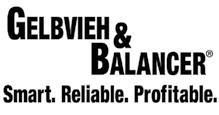
CLIFFORD FARMS
3459 KY HWY 1284E
Cynthiana, KY 41031 Since 1937 (859) 234-6956
BRIAN W. DYER, DVM
BEE LICK GELBVIEHS
CD FARMS
Eddie Reynolds
277 Old Bee Lick Rd. Crab Orchard, KY 40419 606-379-2281(H) 606-305-1972(C)
Clayton & Debbie Cash 1214 Ottawa School Road • Brodhead, KY 40409 (606)-308-3247 • (606)-758-8994
Bulls & Females for sale
Owner/Manager
GELBVIEH/BALANCERS
2050 Glasgow Road Burkesville, KY 42717
Gelbvieh-Balancer Bulls & Heifers For Sale by Private Treaty
Brian, Lauren, Kristen Barry, Emily & Julia (270) 864-5909
GELBVIEH/BALANCERS

Owner/Manager
2050 Glasgow Road • Burkesville, KY 42717
Brian, Lauren, Kristen Barry, Emily & Julia
MURLEY FARMS
REGISTERED GELBVIEH & BALANCER CATTLE
CD FARMS
Specializing in Red Genetics
Clayton & Debbie Cash 1214 Ottawa School Road Brodhead, KY 40409 (606)-308-3247 • (606)-758-8994
Jonathon & Breanna Murley • (270) 427-7727
Gelbvieh-Balancer Bulls & Heifers For Sale by Private Treaty
GELBVIEH BULLS & FEMALES FOR SALE 1012 Shelby Road • Salem, KY 24078 Thad Padon (270) 836-5518
Gary & Pat Tilghman • Carrie & Daryl Derossett Family 690 Lick Branch Road Glasgow, KY 42141 270.646.7024 • pleasantmeadowsfarm@hotmail.
Saturday May 15
Kentucky Junior Gelbvieh Show & Learning Clinic

McIntosh Brothers Farm • 3348 Frankfort Road • Georgetown 10AM Learning Clinic • 12:30PM Show
Call William McIntosh for more information. (502) 867-3132
AA LAND & CATTLE
GELBVIEH & BALANCERS PO Box 781 • Eddyville, KY 42038 (270) 601-6830 • rdowenfarms.com • sales@rdowenfarms.com
Friday May 28 - May 30
Registered Gelbvieh & Balancers Cynthiana, KY Luke Arthur (859) 298-8323 luke.arthur93@gmail.com
AGJA Eastern Regional Junior Show “Run for the Roses”
LARRY CLARK & SONS LLC
Burley Fields Livestock Center • 709 Oil Fields Road • Horse Cave
Bulls • Show Prospects • Embryos
Bulls sell with GE EPD’s • Show Prospects
Registered Gelbvieh Cattle 106 Clark Houk Road • Greensburg, KY 42743
Casey Wright, Owner 2665 Poplar Corner Road • Lebanon, Kentucky 40033 270-692-7496 * donewrightcattle@hotmail.com
Call Carrie Derossett for more information. (270) 404-0828 Entry and room information available at www.gelbvieh.org (Juniors/Regional Shows/AGJA Eastern Regional)
Larry Clark, Owner & Operator (270) 299-5167 • (270) 405-6848 Lpclarkandsons@msn.com BAR IV LIVESTOCK Barry, Beth & Ben Racke
Brad Racke
BREEDING RED & BLACK POLLED GELBVIEH SINCE 1982
Tippenhauer Rd.
Cold Spring, KY 41076
(859) 635-3832 • Barry cell (859) 991-1992
David, Jerri & Jon David: 162 Hastings Ln • Fredonia, KY 42411 (270) 556-4259 Arthur & Joyce Slaughter 19068 Marion Rd • Fredonia, KY 42411 (270)545-3455
FULL CIRCLE FARMS REGISTERED GELBVIEH CATTLE
Brad Burke: 989 Metcalfe Mill Rd, Ewing, KY 41039 (H) 606-267-5609 (C) 606-782-1367 gbb789@windstream.net
EASTERN NATIONAL GELBVIEH SHOW
North American International Livestock Expo, Louisville, Kentucky Junior Show - Sunday, November 17 • Entry deadline - October 8 • Late entries
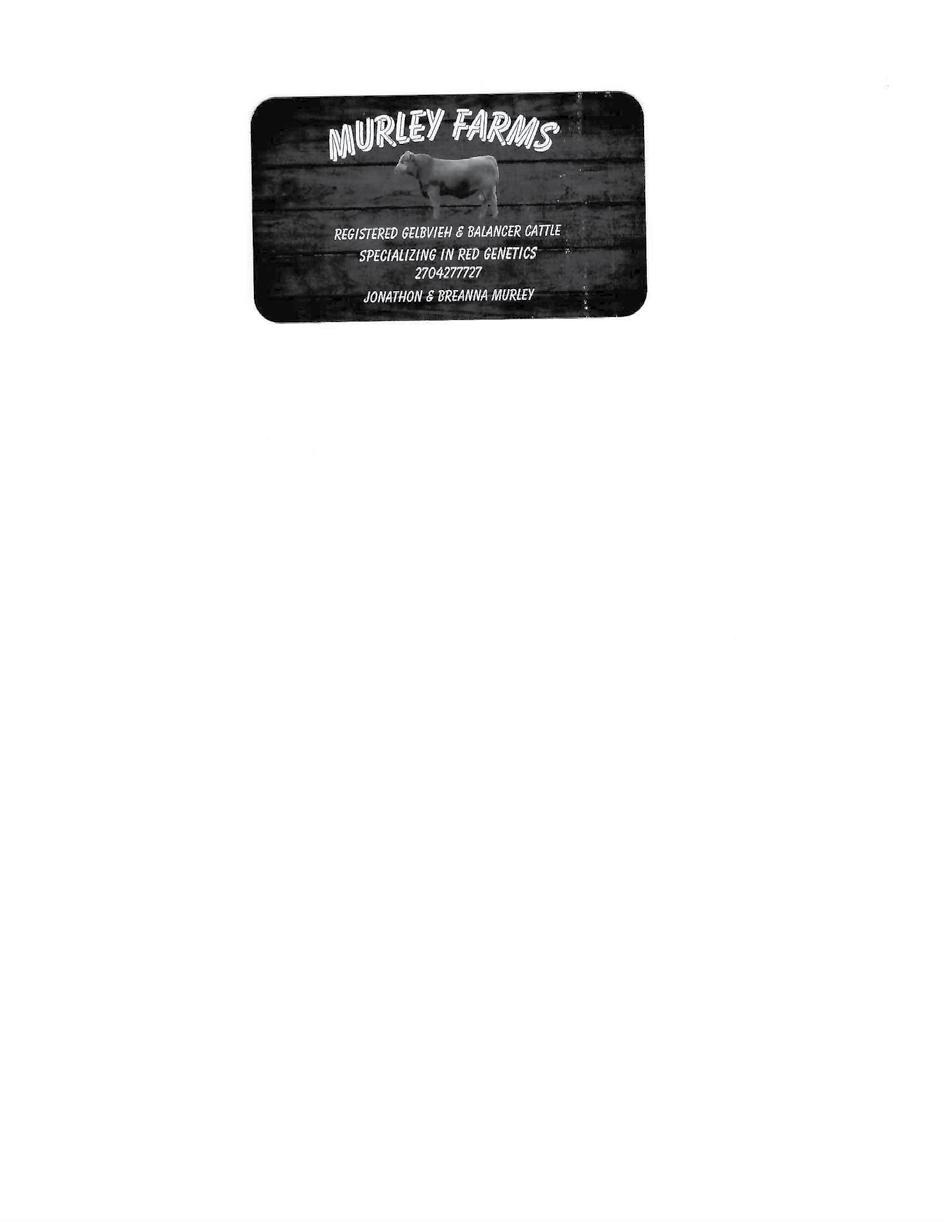



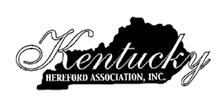

Toby & Debby Dulworth 2492 S. Kirkman Road LaCenter, KY 42056 (270) 224-2993 • dogwood@brtc.net Herefords that thrive on forages. www.dogwoodherefords.com

Codee Guffey • 1815 Grassy Springs Road Versailles, Kentucky 40383 (502) 598-6355 rockridgeherefords@gmail.com www.rockridgeherefords.com
Tony & Kathy Staples 992 Knotts Road
Brandenburg, KY 40108 (270) 422-4220 tstaples@bbtel.com
Registered Polled Herefords
HANSELL PILE, JR.
12045 St. John Rd. Cecilia, KY 42724
270-735-5192
270-862-4462
12 miles West of Elizabethtown
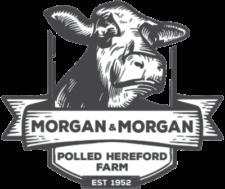
Shannon, Kerry, Emily, Will & Ellie Morgan 13095 Scottsville Rd, Alvaton, Kentucky 42122
www.morganandmorganpolledherefords.com
Shannon: (270) 320-2389
Kentucky Certified Hereford Influenced Sale
Kentucky Beef Expo Schedule
December 12, 2024 Blue Grass Stockyards Lexington
Friday March 1st - Hereford Show - 1pm

Contact Information: L.W. Beckley, DVM, KHA President 859-779-1419
Saturday March 2nd - Hereford Sale - 1pm
Sunday March 3rd - Open Junior Show - 8am
Polled Herefords
439 Flatwoods Frozen Camp Rd, Corbin KY 40701
Bobby & Brenda Wells (606) 523-0569 or (606) 344-0417 wells_farm@yahoo.com
Kevin, Angela, Kenlea & Kyler Murray (606) 528-1691 or (606) 682-8413
Toby & Debby Dulworth 2492 S. Kirkman Road LaCenter, KY 42056 (270) 224-2993 dogwood@brtc.net
Herefords that thrive on forages. www.dogwoodherefords.com

6077 Helena Road
6077 Helena Road
Mayslick, KY 41055
Charlie Boyd II 606-584-5194
Mayslick, KY 41055
Charlie Boyd II 606-584-5194
Annual Bull Sale second Saturday in March Hereford and Angus Bulls
Annual Bull Sale second Saturday in March Hereford and Angus Bulls
Hereford Farms
Brad, Carla, Clay & Clint Chambliss 1101 Driftwood Lane
Elizabethtown, KY 42701
Brad, Carla, Clay & Clint Chambliss 1101 Driftwood Lane Elizabethtown, KY 42701 Home (270) 982-3905 Cell (270) 668-7126 fax 270-735-9922
Home (270) 982-3905
Cell (270) 668-7126 fax 270-735-9922
www.chamblissherefordfarms.com
www.chamblissherefordfarms.com
Registered Polled Herefords Bulls & Females for sale
WCN Polled Herefords
Since 1961
Bill Norris 2220 Celina Road
Burkesville, KY 42717
Tim & Peggy Wolf 12939 Peach Grove Road Alexandria, KY 41001 Home: 859-635-0899 Cell: 859-991-3484
Phone (270) 433-7256
Cell (270) 433-1525
“Every calf needs a white face”

Peyton’s Well Polled Herefords The Lowell Atwood Family 133 Edgewood Drive • Stanford, KY (606) 365-2520 home/fax (606) 669-1455 cell
WELLS FARM Polled Herefords 439 Flatwoods Frozen Camp Rd, Corbin KY 40701
Dale Stith 5239 Old Sardis Pike Mays Lick, KY 41055 dalestith@yahoo.com (918) 760-1550
Bobby & Brenda Wells (606) 523-0569 or (606) 344-0417 wells_farm@yahoo.com
Kevin, Angela, Kenlea & Kyler Murray (606) 528-1691 or (606) 682-8413

President: Chris Hopper 606-584-7842
Secretary/ Treasurer: Melinda Watson 859-625-8660 melindawatson8660@gmail.com
Dale Stith
5239 Old Sardis Pike
Mays Lick, KY 41055
dalestith@yahoo.com (918) 760-1550
Melinda Watson • 859-625-8660 melindawatson8660@gmail.com
K3 CATTLE REGISTERED HEREFORDS
K3 CATTLE REGISTERED HEREFORDS
KYLE BUSH

Versailles, rockridgeherefords@gmail.com www.rockridgeherefords.com
Registered Polled Herefords PAUL L. HANCOCK 8559 KY 56 Owensboro, KY 42301 270-771-4194
Registered Polled Herefords
PAUL L. HANCOCK 8559 KY 56 Owensboro, KY 42301 270-771-4194

K3CATTLE@YAHOO.COM 859-588-4531 198 HICKS PIKE CYNTHIANA, KY 41031
KYLE BUSH K3CATTLE@YAHOO.COM 859-588-4531 198 HICKS PIKE CYNTHIANA, KY 41031
Polled Hereford and Gelbvieh Cattle 3459 KY Hwy. 1284 E. Cythiana, KY 41031 (859) 234-6956
Polled Hereford and Gelbvieh Cattle 3459 KY Hwy. 1284 E. Cythiana, KY 41031 (859) 234-6956
Ben, Jane, Shelby and Lincoln
Ben, Jane, Shelby and Lincoln
Tony 992
Brandenburg, tstaples@bbtel.com
Jackson Farms
Jackson Farms
Registered Polled Herefords PO Box 215 Cross Plains, TN 37049 615-478-4483
Registered Polled Herefords PO Box 215 Cross Plains, TN 37049 615-478-4483
billymjackson@aol.com
billymjackson@aol.com
“Farming the Same Land Since 1834”
“Farming the Same Land Since 1834”

Eric & Ronnie Thomas 2396 Union City Rd. Richmond, KY 40475 (859) 623-5734
Eric & Ronnie Thomas 2396 Union City Rd. Richmond, KY 40475 (859) 623-5734
Eric’s Cell (859) 314-8256
Eric’s Cell (859) 314-8256
“Cattle for sale at all times”
“Cattle for sale at all times”

Jackie D. Perkins II 367 Mt. Pisgah Rd. Bremen, KY 42325 (270) 543-3586
Jackie D. Perkins II 367 Mt. Pisgah Rd. Bremen, KY 42325 (270) 543-3586
Breeding to produce good cows since 1981
Breeding to produce good cows since 1981

Registered HANSELL 12045 Cecilia, 12 miles
Registered Polled Herefords Bulls & Females for sale
BECKLEY HEREFORDS
BECKLEY HEREFORDS
Tim & Peggy Wolf 12939 Peach Grove Road
L. Wayne Beckley • 1420 Fitchburg Rd. Ravenna, KY 40472 • 606-723-3021 Cell: 859-779-0962
Alexandria, KY 41001
Home: 859-635-0899
Cell: 859-991-3484
L.W. Beckley D.V.M 284 Pyrse Lane • Irvine, KY 40336 Cell: 859-779-1419 • Clinic: 606-726-0000 www.beckleyherefords.com

Victor- influenced cattle bred for performance on grass. “Black cows need a good Hereford Bull” Danny Miller jmspolledherefords.com 270-465-6984 270-566-2694
L. Wayne Beckley • 1420 Fitchburg Rd. Ravenna, KY 40472 • 606-723-3021 Cell: 859-779-0962
L.W. Beckley D.V.M
284 Pyrse Lane • Irvine, KY 40336
Cell: 859-779-1419 • Clinic: 606-726-0000 www.beckleyherefords.com
“Breeding Polled Herefords for over 58 Years” Breeding cattle for sale at all times. 1999 Walnut Hill Rd. Lexington, KY 40515 (859) 271-9086 cell (859)533-3790
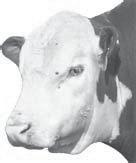
WATSON LAND & CATTLE
Matt, Melinda, Harlee, & Wyatt Watson 6196 Mount Sterling Rd Flemingsburg, Kentucky melindawatson8660@gmail.com - 606-748-1600
Melinda - 859-625-8660
CATTLE FOR SALE AT ALL TIMES
Tucker Stock Farms
“Breeding Polled Herefords for over 58 Years” Breeding cattle for sale at all times.
“Registered Angus and Polled Herefords”
John Tucker II 1790 Hidden Valley Lane Hudson, KY 40145 270-617-0301
1999 Walnut Hill Rd. Lexington, KY 40515 (859) 271-9086
“Bulls always for Sale”

OCT
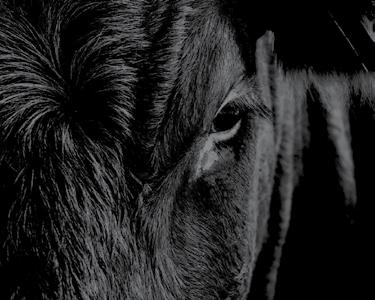
FOUR WINDS FARM N ew Castle, Kentucky (502) 296-1044
PERFORMANCE TESTED PUREBRED ANGUS BULLS FOR SALE
Call 270-202-7186 for more info or check out www.oakhollowangus.com for current availability.
POLLED HERFORD BULLS FOR SALE
19–20-month-old Polled Hereford bulls. Good selection.
Low birthweight, medium frame. Free Delivery Available.
JMS Polled Herefords, Knifley, KY Danny 270-566-2694 Trent 270-566-2000
THE FOUNDATION SALE X
Sat., Sept. 21 2024. 1 PM CT
United Producers, Bowling Green, KY
Selling Fullblood & Purebred Limousin For info, call ACH Holdings LLC
Stephen Haynes 270-799-8685
REGISTERED BLACK SIMMENTAL BULLS
Many blaze faced. Excellent EPD’s. Semen Tested. Delivery Available. Maximize your profit with proven performance. All bulls qualify for new CAIP cost-share. Adam Wheatley 502349-2665
BREEDING AGE HEREFORD BULLS FOR SALE AT ALL TIMES
Over 60 years of Line 1 Hereford Genetics. Groups of open and bred heifers available for sale at all times.
Chambliss Hereford Farms. 270-668-7126
Red Hill Farms, Lafayette, TN, 615-666-3098
Bart, Sarah and Ty Jones
Gordon and Susan Jones, 270-991-2663
VISIT US
- WWW.REDHILLFARMS.NET
Contact us for cattle and semen availability. Annual Production Sales:
More Than a Bull Sale – 3rd Saturday in March
Maternal Monday – 3rd Monday in May
Bulls & Females of Fall Sale – Last Saturday in October
Silage Time:
HS silage wagons 17 and 19 ft- high zcap
Meyer 4516- matching pair- discharges
Miller pro 5200-5300 - tandems
John Deere 3955-75 choppers
New Holland 230-240-790
Rotary Headers-horning 2-3 headers
Fall Drill season
Esch 12 ft- high speed drill
Plant right- 15 ft Tye 7 ft
Call Charlie 859-608-9745
HOOVER NO DOUBT REGISTERED ANGUS YEARLING BULLS
12 available • Excellent EPDs
Docile, Genomic Tested
Contact Triple P Angus, 606-724-5524 or 606-407-2355
SIMMENTAL & SIM ANGUS YEARLING BULLS
Calving Ease, Growth and All Purpose EPDS in Top 25% of Breed
Quality Backed by 40+ years of AI Breeding
Come Take a Look; You Won’t be Disappointed 502-260-7884 or 502-839-6651

Les Anderson Extension Professor, University of Kentucky
This summer has been a challenge for livestock. As of last night, Kentucky has recorded over 35 days with temperatures that have exceeded 90 degrees F, and our temperaturehumidity index has been in the dangerous category for livestock for most of June and July. The impact of heat stress on livestock has been extensively studied over the last several decades. Heat stress reduces growth rate, can shorten gestation and increases lameness, disease and death rates. Perhaps the most dramatic impact of heat stress is the marked reduction in reproductive efficiency.
This early, extended heat has me worried about our cow herd’s reproduction. When I first got to UK, our Angus cows were involved in a variety of trials examining the impact of consuming endophyteinfected fescue on reproduction rate. For several years, these cows were synchronized for AI around June 10 and then exposed to a bull for 70 days. Cows consuming only endophyte-infected fescue had 5562% pregnancy rates at the end of the breeding season. Similarly, Roy Burris at Princeton demonstrated that the conception rate of cows decreased from 70% in early spring (April 1 – June 1) to 35% in the summer (June 20 – Aug. 1), resulting in a pregnancy rate decrease from 90% to 58%. Heat stress reduces pregnancy rate by increasing the abortion rate of young, developing embryos and fetuses. Extreme heat stress results in embryonic/fetal loss for at least the first 45 days of pregnancy. If you are a spring calver and your cattle are consuming endophyte-infected fescue, your cows may have struggled to get pregnant this spring/summer. Plan now to determine pregnancy and hope for the best. Fall-calving cows are not immune to issues with heat stress. Heat stress and consumption of endophyte-infected fescue can induce early labor (30-40 days premature), increase the thickness of
the placenta and increase calf death loss.
Understanding solutions to managing heat stress begins with understanding the problem. Cattle have difficulty dissipating heat effectively because they don’t sweat as well as other animals. Since they don’t sweat well, cattle dissipate heat by increasing their respiration rate, decreasing their activity, dilating their blood vessels near their skin so they can more effectively radiate the heat from their body, and eating less. Eating and digestion generates heat so they intake less feed to reduce the internal blood temperature. In Kentucky, and the rest of the “fescue belt,” heat stress is heightened by consuming endophyte-infected fescue. Endophyte is a fungus that grows in fescue plants, and this fungus produces chemicals, generically called alkaloids that have a variety of negative impacts on animals. One of the main impacts of consumption of endophyte-infected fescue is the alkaloids constrict the blood vessels of the animal, which reduces its ability to dissipate heat via radiation. So, if we want to alleviate issues with heat stress, we need to find management protocols to help cattle dissipate heat. Fortunately, we have options! Logically, the first place to start is simply do not graze endophyteinfected fescue during the summer, but this is often not a viable option for many cattle producers. The breeding season can be shifted to earlier in the spring (April – June vs. May –August), but this will lead to cows calving earlier in the winter, which may not be an acceptable option either. Supplementing with high fat supplements (ex. whole soybeans, liquid fats supplements, distiller's products) during heat stress can increase pregnancy rates in beef cows. Providing a complete mineral mix containing a blend of sodium selenite and selenium yeast, like the UK Beef IRM mineral, has been shown to increase hormone concentrations
necessary to support early gestation. Also, the USDA-ARS research group in Lexington has demonstrated that consumption of red clover can aid cattle during heat stress. Red clover leaves contain chemicals called isoflavones that dilate peripheral blood vessels, reduce heat stress and can increase pregnancy rates. We cannot control the temperature, but we can help our cattle withstand heat stress. Unfortunately, it is a little late for this summer, but we can plan to determine pregnancy in our herd. If you have several open cows, adding a short fall-calving season is an option. We can also use this experience to help develop a plan for heat stress in the future. I cannot predict the future, but I am certain it will get hot most summers and reducing the impact of heat stress is sound livestock management.
Allison Charolais
Charolais Breeder Since
Charolais Breeder Since 1962
Charolais Breeder Since 1962
Bulls Available
Ø Bull calves out of HCR Answer
Bulls Available
HCR SPIRIT 4007.
Ø Bull calves out of HCR Answer 2042 and HCR SPIRIT 4007.
Ø Bull calves out of HCR Answer 2042 and HCR SPIRIT 4007.
Ø Bred for calving ease and growth.
Ø Bred for calving ease and growth.
Ø Bred for calving ease and growth.
Ø Bulls for both purebred and commercial Ø Yearlings and two-year-olds available.
Ø Bulls for both purebred and commercial breeders. Ø Yearlings and two-year-olds available. Ø Bred heifers to calve in fall available.
Ø Bulls for both purebred and commercial breeders.
Ø Bred heifers to calve in fall available.
Ø Yearlings and two-year-olds available.
Ø Bred heifers to calve in fall available.
John Allison, Owner 545 Eminence Road New Castle, KY 40050 502-220-3170
John Allison, Owner 545 Eminence Road New Castle, KY 40050 502-220-3170
220-3170
David Carter, 502-706-0075
David Carter, Farm Manager 502-706-0075
• Bulls should have been removed from the cow herd by now! They should be pastured away from the cow herd with a good fence and allowed to regain lost weight and condition. It is a good time to evaluate physical condition, especially feet and legs. Bulls can be given medical attention and still have plenty of time to recover, e.g., corns, abscesses, split hooves, etc. Don’t keep trying to get open spring cows bred – move them to fall calving or sell them when they wean this year’s calf. If you don’t have a bull pen and want to tighten up the calving season, remove the bull and sell him. Plan on purchasing a new bull next spring. If that is not feasible, then schedule your veterinarian to pregnancy diagnose the herd and cull cows that will calve late.
• Repair and improve corrals for fall working and weaning. Consider having an area to wean calves and retain ownership for postweaning feeding rather than selling “green,” lightweight calves. Plan to participate in CPH-45 feeder calf sales in your area.
• Limited creep feeding can prepare calves for the weaning process since they can become accustomed to eating dry feed. This will especially benefit those calves which you are going to keep for a short postweaning period – like the CPH-45 program. It’s time to start planning the marketing of this year’s calf crop.
• Begin evaluating heifer calves for herd replacements – or culling. Each time you put them through the chute, you can evaluate them for several traits, especially disposition. Consider keeping the older, heavier heifers. They will reach puberty before the onset of the breeding season and have higher conception rates.
• This has been a reasonably good year for pastures, but many parts of the state have experienced some drought. Evaluate moisture condition and consider stockpiling some fescue pastures. It’s not too late to apply nitrogen for stockpiling fescue if moisture conditions are suitable.
• Minimize weaning stresses by spreading-out other activities commonly associated with weaning – like vaccinations, deworming and, perhaps, castration and dehorning (which should have already been done!). Therefore, this month is a good time to do a “preweaning” working of cows and calves.
• When planning the preweaning working, consult with your veterinarian for advice on animal health products and procedures. One procedure that can be done now is pregnancy checking cows. Early pregnancy diagnosis will allow time to make culling decisions prior to weaning time. Feeding non-productive cows through the winter is a costly venture, so pregnancy diagnosis is a business decision for most producers.
• Fall-calving should start this month. Get your eartags ready. Cows should be moved to a clean, accessible pasture and be watched closely. Tag calves soon after they are born and record dam ID and calf birthdate, etc. Castration is less stressful when performed on young animals and calves which are intended for feeders can be implanted now, too.
• If you haven’t started calving quite yet, then it’s time to get ready. Be sure you have the following:
• record book
• eartags for identification
• iodine solution for newborn calf’s navel
• calf puller
• castration equipment
• Watch for those calves which may come early and be prepared to care for them.
• Be on guard for predators – especially black vultures.
• Move cows to best quality fall pasture after calving. Stockpiled fescue should be available to these cows in November-December to meet their nutritional needs for milking and rebreeding.
• Start planning now for the breeding season. If using AI, order supplies, plan matings and order semen now.
• Calves to be backgrounded through the winter can be purchased soon. A good source is Kentucky preconditioned (CPH-45) calves which are immunized and have been preweaned and vaccinated.
• Plan your receiving program. Calves undergo a great deal of stress
associated with weaning, hauling, marketing, and wide fluctuations in environmental temperature at this time of year. Plan a program which avoids stale cattle, get calves consuming water and high-quality feed rapidly. Guard against respiratory diseases and other health problems
General
• Keep a good mineral mix available at all times. The UK Beef IRM Basic Cow-Calf mineral is a good choice.
• Do not give up on fly control in late summer, especially if fly numbers are greater than about 50 flies per animal. You can use a different type of spray or pour-on to kill any resistant flies at the end of fly season.
• Avoid working cattle when temperatures are extremely high – especially those grazing high-endophyte fescue. If cattle must be handled, do so in the early morning.
• Provide shade and water! Cattle will need shade during the hot part of the day. Check water supply frequently – as much as 20 gallons may be required by high producing cows in very hot weather.
• Plan the winter-feeding program. Take forage samples of hay you will feed this winter. Request protein and TDN analysis so that supplemental feed needs may be estimated. Don’t wait until you run out of feed in February to purchase extra feed. Plan to minimize hay storage and feeding losses because feed is too expensive to waste.
• If you have adequate moisture, stockpiling fescue might be a viable option. Nitrogen application to fescue pastures can be made now and allow them to grow and accumulate until November, or when other sources of grazing have been used up. To make best use of this pasture, put fall-calvers, thin spring-calvers or stockers on this pasture and strip graze.
• Don’t graze sorghum or sudan pastures between the first frost and a definite killing frost because of the danger of prussic acid poisoning. Johnsongrass in stalk fields can also be a problem after a light frost. Grazing can resume after the sorghum-type grasses have undergone a killing frost and dried up.



